(1967)[1][2]
_______________________________
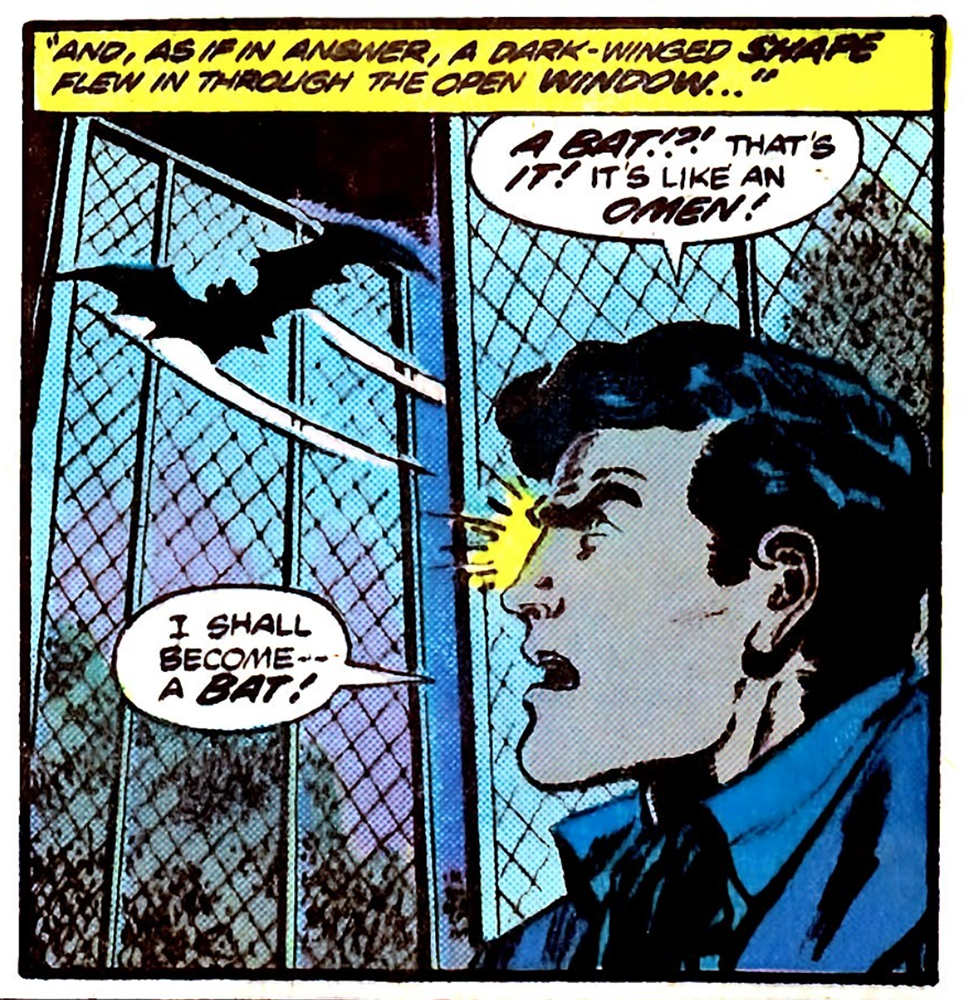
The Untold Legend of the Batman #1 by Len Wein, John Byrne, Jim Aparo, & Glynis Oliver (1980)
–FLASHBACK: From The Untold Legend of the Batman #1, Batman with The Boy Wonder Sunday News Strip 8/13/1967, Batman #200, Batman #232, Batman with The Boy Wonder News Strip 11/16/1971, Batman and The Outsiders #1, Batman Special #1, and Detective Comics #560—and referenced in Detective Comics #396 and Detective Comics #439. Twenty-year-old Bruce Wayne has recently graduated with a degree in criminology.[3] Bruce is also a multimillionaire philanthropist and heir to control of Wayne Enterprises Inc, a publicly-traded corporation that owns industrial, tech, R&D, energy, construction, mining, banking, insurance, and pharmaceutical subsidiaries.[4] (The Wayne Fuel Corporation—as referenced in Superman’s Girl Friend Lois Lane #59 Part 3—is one of the more notable subsidiaries. Wayne Insurance Company, which insures all of Wayne Enterprises, is mentioned via reference in Batman with The Boy Wonder News Strip 7/17/1969. Likewise, Wayne Biotics, Wayne Pharmaceuticals, and the medical testing lab known as The Wayne Research Institute are all referenced in Batman #215.) Vowing to rid Gotham of its criminal underworld as revenge for the murder of his parents back when he was just a boy, Bruce sits in his home and ponders about what he should wear to undertake his vigilante mission, saying aloud, “Criminals are a superstitious cowardly lot, so my disguise must be able to strike terror into their hearts.” As if by fate, a bat flies through his window. This event, coupled with the memory of a masquerade costume his father once wore, prompts Bruce to become a bat-costumed vigilante. As referenced in Batman #253, The Shadow is a direct influence in Bruce’s planning as well. As referenced in Detective Comics #390 and The Brave and The Bold #97, Bruce, in disguise, visits couturier Sam Tweed, who helps him tailor some scary yet durable crime-fighting togs. With a set of awesome protective drip-dry crime-fighting outfits, Bruce becomes Batman. (Batman’s costume is modeled primarily from Thomas Wayne’s old bat-costume, but also inspired by historical texts detailing bat-shaped glider wings once worn by Bruce’s medieval ancestor Lancelot Wayne—as gleaned from a reference in Detective Comics #306. The bat has clearly been an important symbol representing the Wayne family for a very long time.) Be aware that Batman will wear his black insignia costume and his yellow oval costume interchangeably until the publication date of 1964 when he will go permanently with the latter. The concept of Batman using both the black insignia costume and yellow oval costume in his early days is canon via The Untold Legend of the Batman #1-3 and Detective Comics #350 Part 1. Also note that, from this point forward, Batman will periodically meet with Sam Tweed whenever he has costume needs of any kind. As referenced in DC Special Series #15 (Batman Spectacular 1978) Part 3, Bruce also has all of his civilian clothes specially-tailored so that he can wear them overtop of his Bat-costume without anyone noticing and strange lumps or bumps. We can assume that Tweed will alter Bruce’s wardrobe, moving forward.
–REFERENCE: In The Untold Legend of the Batman #1-3, Batman with Robin the Boy Wonder Newspaper Strip 5/30/1966 to 3/17/1967, Detective Comics #362, Detective Comics #368, Batman #196 Part 1, Batman #196 Part 2, Batman with Robin the Boy Wonder Newspaper Strip 1/11/1968, Batman with Robin the Boy Wonder Newspaper Strip 6/1/1968, Batman #199 Part 2, Justice League of America #60, Detective Comics #373 Part 1, Batman with Robin the Boy Wonder Newspaper Strip 11/7/1968, Batman with Robin the Boy Wonder Newspaper Strip 11/19/1968, Batman with Robin the Boy Wonder News Strip 4/24/1969, The Brave and The Bold #77, Batman #201, World’s Finest Comics #175, Batman with Robin the Boy Wonder News Strip 8/5/1969, Batman with Robin the Boy Wonder News Strip 11/28/1969, Batman #206, Detective Comics #381, Detective Comics #384, World’s Finest Comics #163, World’s Finest Comics #182, World’s Finest Comics #190, Detective Comics #392, Detective Comics #408, Swamp Thing #7, Detective Comics #445, Detective Comics #500 Part 5, Detective Comics #504, Detective Comics #508, Detective Comics #548, Batman #220, Batman #273, Batman #276, Justice League of America #149-150, and The Brave and The Bold #151. Batman, still prepping for his first patrol, creates his patented utility belt, which is complete with various helpful accouterments. We will rarely (if ever) see specific alterations to the utility belt on our timeline, but just know that Batman will, moving forward, continuously stock his utility belt with a very wide variety of stuff—smoke bombs, acids, tear gas, lasers, explosive materials, liquid oxygen, catnip, body temperature-reduction pills, skeleton keys, sponge, divining rod, compass, nuclear batteries, sunglasses, a variety of different contact lenses, various powders, earplugs, nasal filters, mini-spy camera, makeup kit, silver iodide pellets, watch, radio transmitter, microphone, bomb-proof mini-tape recorder (with audio cassettes), mobile communicator device, infra-red goggles, mini-watch computer, various wires, pedometer, tweezers, fingerprint kit, evidence collection slides and envelopes, magnifying glass, gas mask/aqualung (rebreather), handcuffs, capsules that expand into lead shields, metal detector, flashlight, lock pick kit (with picks and a stethoscope), flash grenades, rope, grappling hook, Bat-calling cards, pen, notepad, money, and more. If you can imagine it (or even if you can’t), it’s probably in there or will be at some point. The belt is also equipped with an ultra-pressurized carbon dioxide blaster and an emergency proto-GPS tracking device that will allow Batman’s location to be ascertained via computer. In addition to carrying a radio transmitter, the belt itself has a built-in radio transmitter/police scanner that can be interfaced with most computer systems. Batman also creates a battery-powered thermal heating system for his costume that can be switched on and off via a controller on his utility belt. After finishing his utility belt, Batman tests all his equipment.
–REFERENCE: In Justice League of America #167. Batman begins regularly listening to the police and prison radio-scanners to hear all police dispatches and prison guard bulletins. He will continue this practice for the rest of his crime-fighting career.
–REFERENCE: In Batman #208. Bruce proposes to his longtime girlfriend Julie Madison. She says yes and they become engaged to be married.
–REFERENCE: In Batman #208. Since we won’t hear from Uncle Philip Wayne anymore, we must assume that he dies and a funeral is held. Bruce’s other surrogate parent, Mom Alice Chilton is still around and Bruce still remains very close with her. While not specifically shown on our timeline, Bruce will visit her as often as he can for decades to come.
–REFERENCE: In The Untold Legend of the Batman #1, The Brave and The Bold #113, The Brave and The Bold #147, and Batman #367. Now that Philip Wayne is dead, Bruce officially assumes his throne as head of Wayne Enterprises, which is headquartered at a downtown skyscraper that has the word “WAYNE” spelled out with giant light-up letters at its apex. Bruce sets up his top floor office and meets and befriends building doorman/superintendent Ed. Bruce also meets an executive named Al and the entire Wayne Enterprises Board of Directors, each of whom is a major shareholder in the company. We won’t learn all of their names (and they might change over the years), but we are given some, as referenced in Detective Comics #500 Part 7, Batman #339 Part 1, Batman #343, and Batman Annual #10: Ralph Jarrett, Henry Irvine, George Corey, Ted Layne, Frank Endicott, James Grimes, John Forbes, Fred Johnson, Ben Wilson, Mr. Gardner, Mr. Collins, Eric Hammond, Franklin Hersch, and Warren Carstairs. (By 1981, there will be twelve Board members, including Bruce. By 1985, there will be a few more. Bruce will come to know and trust most of these men, getting them to promise never to sell their stocks.) Bruce will always keep spare Bat-costumes and Bat-equipment at work. The prestigious “head of Wayne Enterprises” position comes with several other minor roles too. Bruce’s other responsibilities include sitting on the board of directors for the Gotham Gazette newspaper company (as mentioned in a reference in World’s Finest Comics #80), acting as a trustee for the Gotham Science Foundation (as mentioned in a reference in Batman #111 Part 2), acting as a trustee for the Gotham Museum (as mentioned in Batman #93 Part 3), sharing part ownership of a steel mill (as mentioned in a reference in Superman’s Girl Friend Lois Lane #59 Part 3), owning controlling interest in and acting as director of the Wayne Trust Company Bank (as referenced in Batman with Robin the Boy Wonder News Strip 6/9/1969 and The Brave and The Bold #83), and acting as lead trustee for both the Gotham Community Hospital (as referenced in Batman #212) and Wayne Memorial Hospital (as referenced in Batman with Robin the Boy Wonder News Strip 7/28/1970). Bruce meets fellow hospital trustees, including the affable Dustin. He also meets and befriends one of his colleagues at the Gotham Museum, Dr. Sayre. Bruce also becomes acting director of the Gotham City National Bank (as referenced in Batman #296). There, he meets and befriends his fellow bank directors, including Mr. Baldwin. Bruce also becomes Chairman of the Board for the Zenith Oil Corporation (as referenced in The Brave and The Bold #83), which matches-up monopolistically and synergistically with his lead position at Wayne Fuel Corporation. He meets the other Zenith Oil Corp board members, including Grantland Stark. Note that, moving ahead on our timeline, Bruce—as the head of Wayne Enterprises—will have a near constant engagement with the company’s business, finance, and tech dealings. This will be done mostly to keep up appearances, but will still take up a lot of Bruce’s time in-between Batman cases. We won’t see much of this activity on the timeline below, but, suffice to say, we should imagine it occurring invisibly as we move forward.
–REFERENCE: In Detective Comics #306 and referenced in The Brave and The Bold #83. I hate when querulous people complain that Bruce Wayne doesn’t spend his money to help those in need, choosing only to fund his private militarized war on crime. This simply isn’t true. As we learn in ‘tec #306, Bruce now starts several charity drives, designed specifically to help the needy. He will continue to head charities on-and-off for the next several years (although we won’t actually see these unspecified charity drives listed on our timeline). In a related move, Bruce decides to donate any money he personally earns through the Zenith Oil Corporation to charity.
–REFERENCE: In The Untold Legend of the Batman #2, Batman #164 Part 1, Batman #213, Detective Comics #366, Batman with Robin the Boy Wonder News Strip 7/16/1967, Batman with Robin the Boy Wonder News Strip 8/15/1967 to 8/17/1967, Batman with Robin the Boy Wonder News Strip 8/14/1968, Batman with Robin the Boy Wonder News Strip 11/14/1968 to 11/15/1968, Batman with Robin the Boy Wonder News Strip 2/4/1969, Batman with Robin the Boy Wonder News Strip 4/24/1969, Batman with Robin the Boy Wonder News Strip 1/28/1970, The Brave and The Bold #82, Batman #222, The Brave and The Bold #111, The Brave and The Bold #183, Batman #261, Batman #274, DC Special #28 Part 1, Batman Family #11 Part 3, World’s Finest Comics #290, and World’s Finest Comics #301. Bruce completes prep work before beginning construction on the Batcave, the underground cavern lair beneath his palatial mansion home of Wayne Manor. Despite the Batcave being a work in progress, Batman immediately begins operating out of it, filling it with various crime-fighting tools and numerous vehicles (cars, boats, planes, planes that turn into submarines, helicopters, sub-orbital rocket, and more). All of these vehicles will have futuristic tech that no one else has yet, including autopilot capability. The cars, which Batman will call “Batmobiles,” each have an ignition starter that requires a passcode to activate (hidden behind a phony radio). There are combination locks protecting various compartments inside each Batmobile as well. (Batman #213 tells us that Batman’s first Batmobile is an unmarked sedan roadster.) In addition to the amazing Batcave garage where most of the vehicles are stored, Batman also constructs a training facility, medical center, fully-stocked library, industrial design studio, and a state-of-the-art crime lab that has high-tech detective equipment, science equipment, a rogues gallery police catalog, a photography dark room, and a high-powered Bat-computer. (Moving forward, Batman will include detailed files on acquaintances, fellow superheroes, and the arch-rivals of his fellow superheroes in Bat-computer databases. However, the Dark Knight will make sure, for security purposes, that there is no information about himself in these files. Batman will also store detailed crime-files—containing information on active, jailed, and reformed criminals—in the Batcave, always keeping them up-to-date. These crime-files will be a combination of both analog physical files and computerized data.) Batman, who already has a tape recorder in his utility belt, also wirelessly connects his belt microphone to a separate tape recorder in the crime lab, thus making backup copies for his audio cassettes. The Batcave also gets multiple roadway exits for the Batmobile, one that goes through a barn near the edge of the Wayne property line and one that goes through a false rock wall a few miles away. The barn also has a retractable roof for aerial vehicles. All secret entrances to the cave can be opened via remote control. These entries and exits are built with security systems and alarms, complete with self destruct mechanisms that can be detonated either via a key in the Batcave or by secret buttons in Wayne Manor. Note that the Batcave also includes secret entries to Gotham’s sewer system and to a connected underground river that runs into Gotham Bay. This river is one of the longest underground waterways in the world, so keeping it hidden is no small task. We can assume that, aside from sophisticated camouflaging means, Batman uses his vast resources to erase geological history records in order to keep this secret safe. Batman also walls off any connections to the greater cavern system. He likely will utilize false seismic echo generators to fool radio frequencies or ground-penetrating radar as well. And, last but not least, Bruce connects the Batcave to Wayne Manor via secret passageways and hidden elevators. There are multiple secret entrances to the Batcave, the most famous of which lies behind an old grandfather clock in one of the main living rooms of the mansion.
–REFERENCE: In Detective Comics #551. Batman sets up the grandfather clock (the one that hides a secret entrance to the Batcave) to sound a single chime whenever anyone enters the caverns below.
–REFERENCE: In The Brave and The Bold #160. Batman puts spare utility belts (fully stocked) into a majority of his vehicles.
–REFERENCE: In World’s Finest Comics #141, World’s Finest Comics #149, and World’s Finest Comics #168. Batman puts various alarms inside Wayne Manor that will go off should anyone enter the Batcave.
–REFERENCE: In Batman #133 Part 2 and World’s Finest Comics #323. Batman constructs a variety of boomerang weapons that he calls “Batarangs.” These weapons, which do all sorts of tricks and serve many different purposes in the field, are stored on a neat display in the Batcave. We will have to imagine Batman using the Bomb Batarang, Flashbulb Batarang, Magnetic Batarang, Smoke Batarang, and others randomly on our timeline. (Obsessed with his motif, Bruce will add a “Bat” prefix to the name of just about every weapon, tool, or vehicle he uses in his crime-fighting mission.)
–REFERENCE: In Batman #222. Batman begins learning photography. He will eventually master the art (shooting), science (developing), and technology (camera repairing) behind photography.
–REFERENCE: In Detective Comics #360 Intro. Batman begins familiarizing himself with underworld lingo. Batman will keep up to date with all the latest street slang from here on out.
–REFERENCE: In referenced in World’s Finest Comics #164. Batman vows to uphold a strict no killing rule. While he will act with extreme violence, Batman will only fight crime using non-lethal methods. (In the future, Batman will, only on very rare occasion, accidentally kill in self-defense.)[5]
–REFERENCE: In World’s Finest Comics #169 and Batman with Robin the Boy Wonder News Strip 7/14/1967. Batman constructs a camouflaged runway on the outskirts of the Wayne Manor property. This concealed runway will allow Batman to land and store the Batplane outside of the Batcave, if needed, in the future. They will also sometimes park the Batmobile there as well. NOTE: The Batplane is also known as the Bat-jet. Same vehicle. I’ll use both names interchangeably, moving forward.
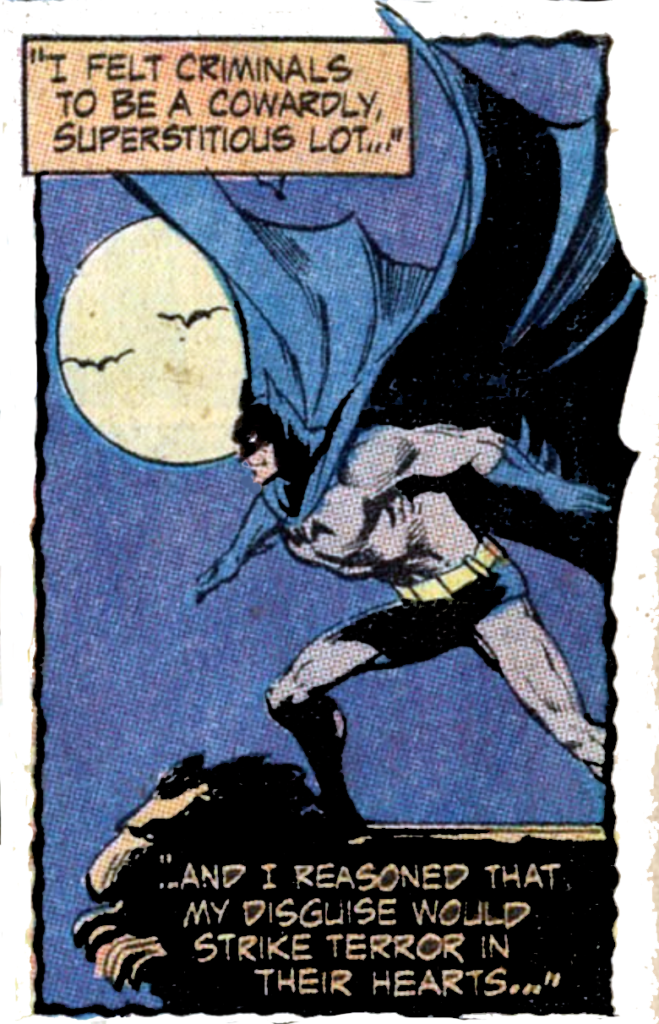
Batman #232 by Denny O’Neil, Neal Adams, & Dick Giordano (1971)
–FLASHBACK: From Justice League of America #37, Batman with The Boy Wonder Sunday News Strip 8/13/1967, and Batman #232—originally told in Detective Comics #27. Batman finally goes on his first ever street patrol and completes his first mission, “The Case of the Chemical Syndicate,” which reveals his existence to the public. In this case, Batman busts some crooked gangsters linked to a chemical factory. From this point forward, Batman will be referred to by various nicknames, including “Dark Knight,” “Caped Crusader,” “Dark Detective,” “Masked Manhunter,” and “World’s Greatest Detective.” The broken 1976 Super DC Calendar inexplicably places the “Case of the Chemical Syndicate” in December, which is dead wrong and must be ignored.
–REFERENCE: In Batman #298, Batman #303 Part 1, Batman #304 Part 2, and Batman #308. Batman begins what will be a general routine of ending his nightly patrol at around five o’clock AM (barring special circumstances, of course). Batman, from this point forward, usually get two to four hours of sleep, waking up between seven and nine o’clock AM for a gym workout, followed by the Wayne Enterprises work day. Of course, part of his Wayne Enterprises workday will include an afternoon power nap. Also, Bruce will dedicate one daytime hour of every week to focusing solely upon Wayne Enterprises work, during which he is not to be bothered by anyone.
–REFERENCE: In Batman Special #1. Now that Bruce has gotten his anti-crime protocol underway, he starts a new routine in his civilian life—making a weekly visit (when he can) to see his parents’ graves at Crown Hill Cemetery. Bruce will keep in close touch with Crown Hill trustee and family friend Arthur Childress as well. Note that there’s no way in sweet hell that Bruce will have the time to get to Crown Hill every single week. We’ll have to simply imagine him getting there every once in a while.
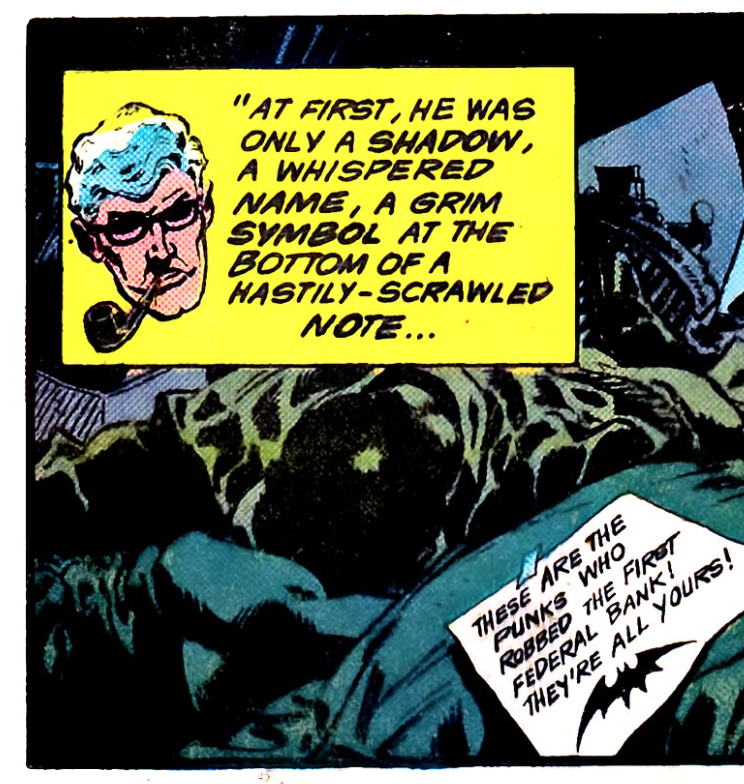
The Untold Legend of the Batman #3 by Len Wein, Jim Aparo, & Glynis Oliver (1980)
–FLASHBACK: From The Untold Legend of the Batman #3 and Batman with The Boy Wonder News Strip 11/16/1971. Batman continues to announce his arrival to the public by apprehending wanted bank robbers and leaving them each with a note for the Gotham City Police Department (GCPD) Commissioner James Gordon. Batman immediately goes onto the GCPD’s Most Wanted list. In spite of this, he will continue busting criminals and leaving them with notes for the cops.
–REFERENCE: In Detective Comics #256. Batman busts crook Pete Cole.
–REFERENCE: In Batman with Robin and Galexo News Strip 4/5/1972. Bruce hires an unnamed business manager to handle the day-to-day affairs at Wayne Enterprises and his other holdings. While we won’t ever see him, this person will help runs things for the next decade, thus providing extra time and space away from the office, so that Bruce can do Batman stuff.
–REFERENCE: In Detective Comics #367, Detective Comics #374, Detective Comics #412, Batman #285, and Batman #303 Part 2. Batman begins recording the full details about all of his patrols and adventures, either written-out or audio-captured. These “official case-file” journals are stored in the Batcave. (Once Robin debuts, he will record all his solo missions in these journals too.) Notably, Batman also begins keeping a separate scrapbook—a private archive/”black casebook” that will allow him to write more personal diary-like entries for extra-special cases. Batman also keeps a third case-file audio-journal known as the “time capsule,” for cases involving highly-sensitive information. The idea with the “time capsule” files are that they will be sealed and only accessible decades down the road, long after Batman’s career has ended.
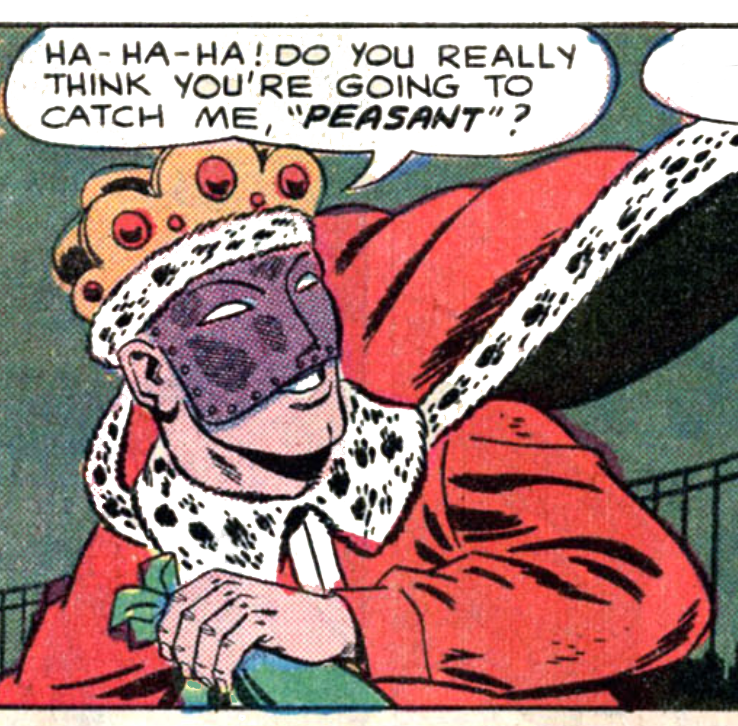
Detective Comics #350 by Robert Kanigher, Sheldon Moldoff, & Joe Giella (1966)
–FLASHBACK: From Detective Comics #350 Part 1. Batman encounters his first ever costumed super-villain, the regal-themed Monarch of Menace. Using a variety of gimmicked weapons and gaudy medieval-dressed henchmen, the Monarch of Menace makes a fool of Batman and the police, not just once, but several times in a row. After defeating the inexperienced and frustrated Dark Knight multiple times, the Monarch of Menace disappears without a trace. We won’t see the patrician-styled thief for quite some time.
–FLASHBACK: From Detective Comics #366. Bruce attends a Gotham Garden Sports Show with Commissioner Gordon and famous sports writer Fred Tinney, after which the trio helps nightwatchman John Kobler bust crook Doc Hastings.
–REFERENCE: In The Brave and The Bold #98 Intro and The Brave and The Bold #98. Batman saves the lives of Roger Birnam and his pregnant wife Clorinda Birnam. The Birnams are so grateful they ask Batman to be the godfather to their child. Batman agrees. A few days later, after the baby is born, Batman meets his godson Enoch Birnam). While we won’t see it on our timeline, Batman will stay in touch with the Birnams quite often and sporadically visit them throughout the decade to follow. (Unknown to poor Roger and a completely unsuspecting Batman, Clorinda is the secret head of a coven of witches and she, with the help of coven member Dr. Malthus, has delivered twins. Enoch is an evil demon-baby while his brother, Roger Birnam Jr, is the good child. Roger Jr will be kept hidden from the world. So, yes, Batman is basically Rosemary’s Baby’s godfather.)
–FLASHBACK: From Batman #129 Part 2—and referenced in World’s Finest Comics #194 and Batman #232. Bruce attends a Haly’s Circus performance in the Newtown section of Gotham City. During the trapeze act, aerialists John Grayson and Mary Grayson (aka The Flying Graysons) fall to their deaths, orphaning their only child, ten-year-old acrobat Dick Grayson. (Notably, writer Marv Wolfman, in New Teen Titans #37, states that Dick is eight-years-old when he becomes Robin, but this is a continuity error. It’s just not feasible for that to be the case and jibe with his high school and college education timeline.) The speechless crowd and fellow circus folk, including clown Waldo Flynn, are mortified at the tragedy that has occurred. (Notably, Batman #232 tells us Bruce is present at the circus at the exact moment of tragedy, although no depictions of the performance in any comics actually visually show Bruce there. Instead, they only show nondescript wide shots of the audience.) Our story continues (via flashback from Batman #129 Part 2) with Batman examining the scene of the Grayson murders, after which he addresses CC Haly, owner of Haly’s Circus, telling him that the trapeze ropes that failed and killed the Graysons were deliberately rigged. Haly reveals to Batman that racketeers had been threatening him lately. Nearby, a distraught Dick is comforted by his friend Sando the Strongman. Later that very same night, after gathering evidence, Batman busts the Grayson killers—racketeers from the Zucco Mob (led by Boss Tony Zucco), including the man who rigged the ropes, a gangster named Blade. (Blade wont stay locked up for very long and will soon be back out on the streets in no time flat.) Note that the typically-unreliable 1976 Super DC Calendar places this item in July, but that is incorrect.
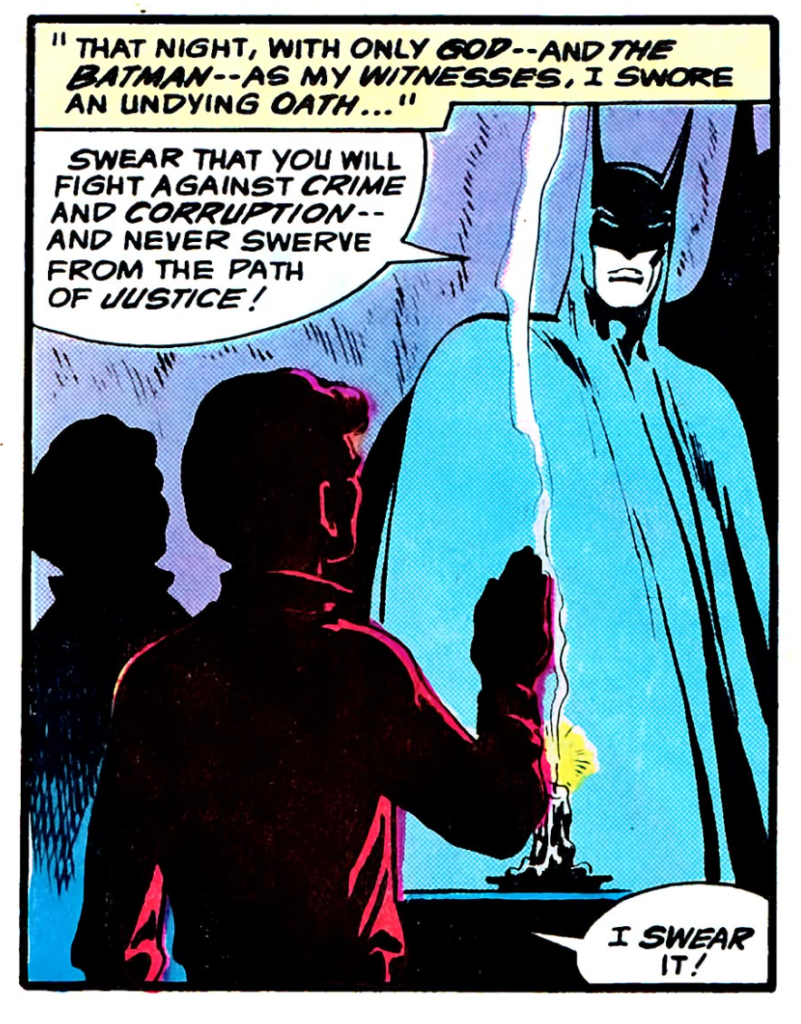
The Untold Legend of the Batman #2 by Len Wein, Jim Aparo, & Glynis Oliver (1980)
–FLASHBACK: From The Untold Legend of the Batman #2, Batman with The Boy Wonder Sunday News Strip 8/13/1967, Batman #200, Batman #213, World’s Finest Comics #200, Batman #232, Batman #244 Part 2, Batman #300, Batman #339 Part 2, Detective Comics #484 Part 4, and Detective Comics #526—and referenced in The Brave and The Bold #83 and Batman Family #7. Late on the same night of the Graysons’ deaths (immediately following the arrest of Blade), Dick overhears more Zucco Mob members threaten CC Haly yet again. Dick tries to lash out, but Batman meets with him and calms him down. Both Batman and Dick now know with utmost certainty that the death of the Flying Graysons was foul play orchestrated by Boss Zucco. In fact, Batman has already arrested those responsible for the actual murders (Blade and company). Nevertheless, even with the incriminating information at his disposal, the Dark Knight knows it will still be very hard to link Boss Zucco directly to the crime. Seeing a bit of himself in the orphaned Dick, Batman reveals his secret ID to the boy and takes him under his wing, agreeing to help him get revenge. But first, they’ll need to gather evidence and build a stronger case against Zucco. (The scene where Batman and Dick talk about partnering-up occurs in the Batmobile. However, in a flashback from Batman #129 Part 2, the scene incorrectly happens at the circus. Notably, the same scene in Batman #213 correctly takes place in the Batmobile, but it shows the wrong Batmobile i.e. the original sedan roadster version of the Batmobile. While Batman’s sedan exists, it isn’t the version of the car driven in this scene thanks to a retcon from The Untold Legend of the Batman #2.) That night, Dick swears a special oath of dedication to Batman. The very next day, with consent from Dick’s closest relatives (including his Aunt Harriet Cooper), Dick becomes Bruce’s legally adopted ward. Bruce also starts Dick out with a very generous allowance befit for one of the now-richest kids in Gotham.
–FLASHBACK: From Batman #129 Part 2, Batman #213, Detective Comics #484 Part 4, and Batman #339 Part 2. Dick begins an extensive and strenuous training session, starting with trapeze, boxing, jiu jitsu, judo lessons, and crime detection classes. (Batman tells Dick that he could teach him a few things about trapeze.) As referenced in Batman #189, Batman goes over the “rules of soldier combat.” Not sure how many rules there are or what they are, as we only learn Rule #2: “Call out if separated or obstructed from view of your partner while fighting in the field.” In a reference in The Untold Legend of the Batman #2, we are told that Dick’s training lasts “months”—I’m not sure how long that is supposed to be, but for the sake of time-compression and the need to accommodate a ton of stories in this first year, I’m going to say that it is a mere three months. Batman will teach Dick everything he knows. While Dick trains, Batman begins his case against Zucco. As referenced in Batman Family #7, in Dick, Bruce will quickly see bright intelligence, intense alacrity, and a level of skill that he’s never seen before in someone so young.
–REFERENCE: In Batman #208. Bruce introduces Dick to his surrogate parent, the woman that helped raise him after his parents died: Alice “Mom” Chilton (Joe Chill’s mother). Bruce and Dick will visit Mom Chilton as often as they can, moving forward. It won’t be long before the clever Alice realizes that Bruce is Batman, but she won’t ever mention to him that she knows the truth. Alice also knows that her son Joe was responsible for killing the Waynes, but she won’t ever reveal this fact to Bruce either.
–REFERENCE: In The Untold Legend of the Batman #3. During Dick’s training period, Batman continues busting small-time crooks and leaving them tied-up with notes attached.
–REFERENCE: In New Teen Titans #38. Batman tells Dick that, while conducting an investigation, one clue will lead to another, and then another, and so on and so forth. This is a lesson that Batman will oft repeat to Dick for many years to come.
–REFERENCE: In Batman with Robin the Boy Wonder News Strip 7/9/1969 and Batman with Robin the Boy Wonder News Strip 10/15/1969 to 10/16/1969. Bruce and Dick both begin learning how to scuba dive. They begin doing various underwater training sessions.
–REFERENCE: In Detective Comics #360-361. Batman begins training Dick in escape artistry. Batman tells Dick that there is no such thing as an inescapable trap.
–REFERENCE: In Batman with Robin the Boy Wonder News Strip 3/16/1969. Batman stresses the importance of being kind to animals to Dick. He tells his ward never to kill animals for sport either.
–FLASHBACK: From The Untold Legend of the Batman #2 and Batman #200. Dick’s training continues for a couple more months.
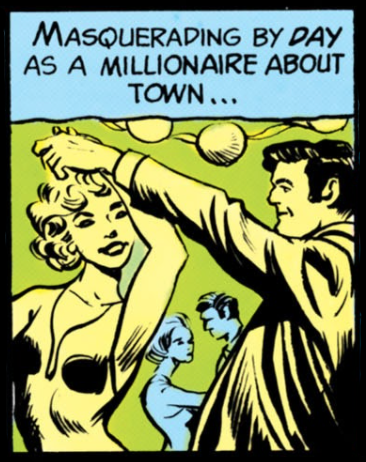
Batman #301 by David Vern Reed, John Calnan, Tex Blaisdell, & Jerry Serpe (1978)
–FLASHBACK: From Batman #301—and referenced in The Untold Legend of the Batman #2, Detective Comics #237, Batman #117 Part 2, Batman #303 Part 1, World’s Finest Comics #194, World’s Finest Comics #283, The Brave and The Bold #101, and Batman #356. Multiple rumors abound that Bruce Wayne could be the mysterious Batman. In order to throw the public off the correct trail, Bruce amplifies his lazy socialite persona in order to convince prying folks that there is no way he could possibly be Batman. Bruce begins playing ten-goal polo, joining a high-society equestrian league. Bruce befriends philanthropist Dan Hunter at the equestrian league, with whom he will spend a lot of time in the coming years (although we must imagine these polo game hangouts invisibly sprinkled throughout our timeline). Bruce also becomes an avid foodie and wine connoisseur, begins attending parties, and starts going on lots of dates. To further to the confusion, Bruce appears in public claiming to be Batman disguised as Bruce! This bizarre trick will be done periodically, moving forward, to keep people dizzy. Bruce’s spoiled, polo-playing playboy persona will be a main part of his secret ID for his entire career—although he will eventually wean off playing polo as the years wear on. In building-up this carefree rich boy façade, Bruce will befriend a ton of random high society types (many of whom we must simply imagine appearing on our chronology over the course of the next decade-plus). He will also begin spending a decent amount of time at various lounges, clubs, and the horse racing track.
–REFERENCE: In Batman #208. While galavanting between various cafe society shindigs and patrician clubs, Bruce learns that his college friend Linda Page has become conspicuously absent from the scene. Unknown to Bruce and the rest of Gotham’s aristocracy, Linda has gained a conscience and is in training to become a registered nurse.
–REFERENCE: In World’s Finest Comics #287. Bruce attends a charity fundraiser held by his bud Dan Hunter. Bruce donates a ton. While we won’t physically see them on our timeline ahead, Dan will host many charity fundraisers, and Bruce will always attend with his checkbook ready to go.
–REFERENCE: In The Brave and The Bold #194. Delving deeply into his playboy persona, Bruce meets and befriends a few rich Gotham socialites—Bianca, Brooke, and an unnamed couple. Bruce will be friends with these folks for decades to come.
–REFERENCE: In Batman Annual #9 Part 2. Bruce meets and befriends a rich Gotham socialite named Rawlins. Bruce will be friends with him for decades to come.
–REFERENCE: In Batman #98 Part 2 and Batman #117 Part 2. Part of Bruce’s attempt to pump-up his decadent Richie Rich character includes joining the elitist Millionaires’ Club, a Gotham club for the wealthiest-of-wealthy only. As also referenced in Batman #98 Part 2, Bruce, realizing the public already links him with Batman, openly reveals that, while he doesn’t know who the Caped Crusader is, they are close friends. NOTE: While not specifically shown or referenced in Batman #98 Part 2, we can assume that Bruce meets his fellow Millionaires’ Club Committee members, Upton and Connors (as referenced in Batman #117 Part 2).
–REFERENCE: In Batman #134 Part 2. Bruce continues to bolster his rich playboy image by joining the Sportsmen’s Club. Bruce befriends and introduces Dick to some of the club’s members, notably wealthy importer Tod Allen. Bruce also introduces Dick to some high-society types, including the vapid Freddy, Don Eagle, and Perry Wren.
–REFERENCE: In Detective Comics #311. At the Sportsmen’s Club, Bruce meets member Thomas Blake, who departs for a long gig hunting and trapping big cats in India.
–REFERENCE: In The Brave and The Bold #200 Part 2. Bruce joins yet another fancy socialite club, the Ancient Greece-themed Hellenic Club. Bruce won’t attend this one much, which will eventually lead to his membership quietly expiring.
–REFERENCE: In Detective Comics #304. Bruce continues to ramp-up his socialite playboy image, joining yet another prestigious “rich man’s organization,” the Pharaoh Club. Bruce, because of his vast wealth, is made a high-ranking member of the “Rules Committee,” getting to decide who gets to be in the club. He meets other Pharaoh Clubbers, genius scientist Professor Colton and multimillionaire with false teeth Phipps. Bruce will randomly (and invisibly) attend the Pharaoh Club’s lounge going forward on our timeline, keeping in close touch with the reclusive workaholic Professor Colton.
–REFERENCE: In Batman #158 Part 2. Bruce joins another rich organization, the Explorer’s Club. He meets and befriends fellow member Matt Carter.
–REFERENCE: In Batman #157 Part 2 and Batman #249. Bruce joins another gross fraternity for over-privileged white men, the notorious Gotham Men’s Club. There he meets and “befriends” some of the club’s senior members, including the misogynist aporophobic Stanford. Bruce also meets another member named Blythe. Horrifically, in order to enter into the senior ranks of the club, one must do horrible things to “prove his superiority.” This white supremacist organization truly is the worst club in the city, by far. Bruce won’t engage with the Gotham Men’s Club very often, moving forward, but he will pay his dues to keep up appearances.
–REFERENCE: In World’s Finest Comics #150. Bruce meets and befriends a man named Carson at one of his club organizations.
–REFERENCE: In Detective Comics #373 Part 1. Bruce meets and befriends Osgood Harris and billionaire Ralph Porter.
–REFERENCE: In Batman #247. Bruce, likely at one of (or several of) his clubs, meets and befriends rich socialites Wilson Ennet, Sandour Grogan, and Marsden Van Dyne III.
–REFERENCE: In Batman #339 Part 1 and Detective Comics #508. Bruce joins the bourgeois Empire Club, meeting all of its elite members, including museum curator Gregory Griffin and politician Hamilton Hill. While we won’t see it on our timeline, Bruce and Hill will hang out from time-to-time over the course of the next decade. Bruce will also keep tabs-on all Empire Club members new and old, moving forward. Bruce will also become quite close with Griffin.
–REFERENCE: In Batman #166 Part 2. While on the continuing topic of bolstering his wealthy socialite credibility, Bruce now throws what will be the start of many fancy parties and galas at Wayne Manor. Bruce will hold these parties for decades to come. While the vast majority of these shindigs won’t actually be seen on our timeline, Bruce will always use the same trusty catering service.
–REFERENCE: In Batman #111 Part 2. In the Golden Age, Bruce Wayne and Commissioner Gordon were very close friends and the Commish indulged Bruce’s “amateur interest” in criminology on more than one occasion. However, in the Silver Age, Bruce and Gordon have a slightly different relationship. While it remains true that Bruce and Gordon are “old friends,” having known each other for years (as referenced in Detective Comics #249), Gordon now comes to regard Bruce as nothing more than a rich idler, buying into his playboy persona hook, line, and sinker. Thus, despite their history, Gordon personally downgrades his relationship with Bruce from legit “friend” to mere “acquaintance.”
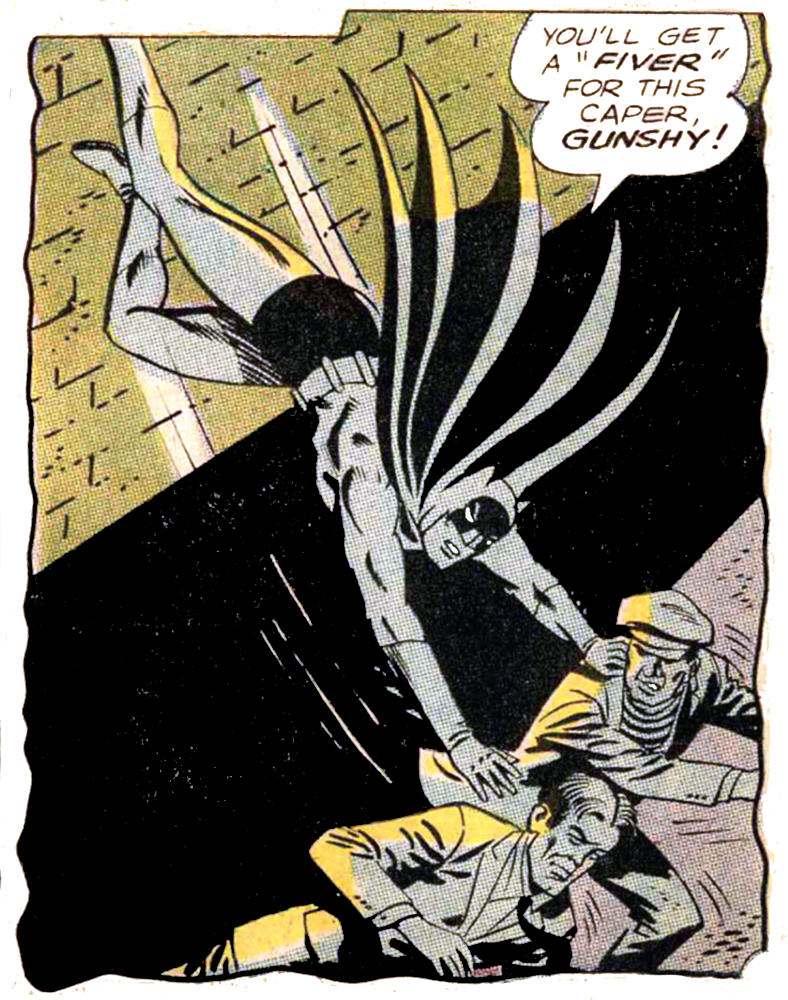
Detective Comics #360 by Gardner Fox, Sheldon Moldoff, & Joe Giella (1967)
–FLASHBACK: From Detective Comics #360 Intro—and also referenced in Batman #190 and Batman #201. Batman invents a new radar detector called the “seismokon,” which he installs in all his Bat-vehicles. This device acts as a long range motion-detector, able to scan for activity in commercial buildings after business hours have ended. The seismokon soon leads him to a robbery in progress being committed by gangster Gunshy Barton and his cronies. Batman easily busts them. Note that the seismokon will be a permanent feature in all Bat-vehicles. Thankfully, the seismokon will rarely be referred to by its ridiculous name—more often it will simply be called “radar,” “sonar,” “Bat-radar,” “sonar-oscillator,” or “Bat-tector.”
–REFERENCE: In Batman #267. Batman begins learning the art of pickpocketing.
–REFERENCE: In Detective Comics #454. In an effort to discover any hidden flaws in his fighting technique, Batman has Dick study his every move while training. They discover that Batman has a natural reflex—he squints his right eye ever so slightly before delivering a righthand punch or left leg kick. And he does the same on the left side, squinting his left eye when striking from the left.
–REFERENCE: In Detective Comics #495 Part 5. Bruce begins teaching Dick all about business. He will teach Dick about business, finance, and other related topics for a decade to come.
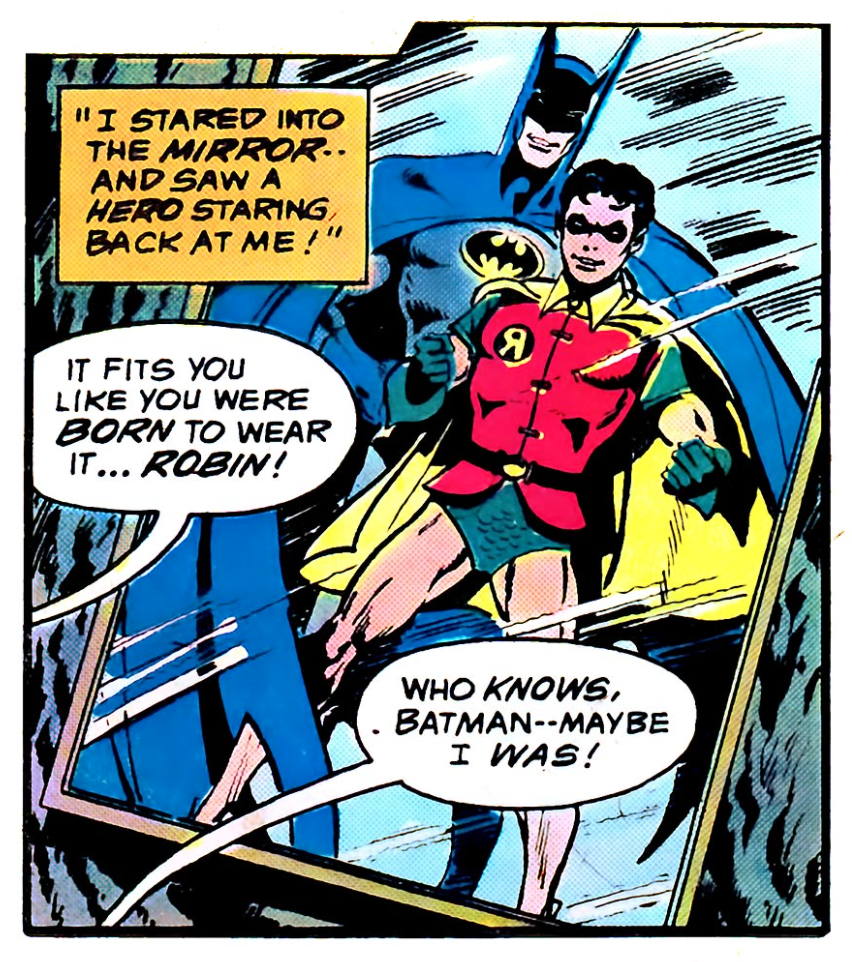
The Untold Legend of the Batman #2 by Len Wein, Jim Aparo, & Glynis Oliver (1980)
–FLASHBACK: From The Untold Legend of the Batman #2, Batman with The Boy Wonder News Strip 11/19/1971, Batman #213, Batman #339 Part 2, and Detective Comics #484 Part 4—and also referenced in Batman #200. June—the unreliable 1976 Super DC Calendar places Robin’s debut in August, but that is incorrect. Dick’s training ends. Batman gives him a showy costume similar to the one he once wore when he was a pre-adolescent kid training with Harvey Harris. (Bruce has personally sewn together this outfit, but presumably, per reference in Detective Comics #390, Batman’s costumier Sam Tweed will tailor Robin’s duds in the future.) Batman also reveals that he now has enough evidence to go after Boss Tony Zucco. The Boy Wonder, Robin, is officially born. A day later, Batman sends his new sidekick to spy on Tony Zucco (undercover dressed as a newsboy). With new dirt on Zucco, Batman busts up several Zucco operations and sends him a threatening letter along with a live bat! Batman and Robin then bust Tony Zucco and his number one man Blade. When a caught Blade squeals, Zucco kills him. Batman and Robin then bust Zucco and send him to Death Row. Later, Bruce decides that Dick can live a civilian life since he’s avenged his parents’ deaths. However, Dick tells Bruce he wants to be his permanent partner. Bruce agrees!
–REFERENCE: In Detective Comics #484 Part 4. Bruce begins sending anonymous checks to CC Haly, helping him keep his circus afloat. Bruce will regularly send these checks for decades to come.
–REFERENCE: In Batman #166 Part 1, Detective Comics #362, Batman with Robin the Boy Wonder News Strip 11/5/1968 to 11/6/1968, Batman #253, Batman #278, and Detective Comics #500 Part 7. Batman and Robin begin patrolling nearly every single night, prepping their anti-crime movements based off maps of Gotham that have been divided into “patrol sectors.” They patrol based on the ebbs and flows of the city, often re-patrolling certain routes at times when concerts, shows, or bars are letting out. They will use these methods going forward. Likewise, Batman and Robin begin to familiarize themselves with Gotham’s every nook-and-cranny, from the rooftops to the sewers and everything in-between. From this point forward, Batman and Robin will constantly be aware of infrastructural alterations to the cityscape, including new construction or specific changes to residential, industrial, and commercial zones. Furthermore, Batman and Robin begin to familiarize themselves with the landscape and terrain outside of the city limits as well, learning suburban and upstate zip codes, trail routes, waterway maps, and what types of rock make up nearby sediment walls and mountains. Batman and Robin will keep detailed and updated chart-files containing all of this info, moving forward.
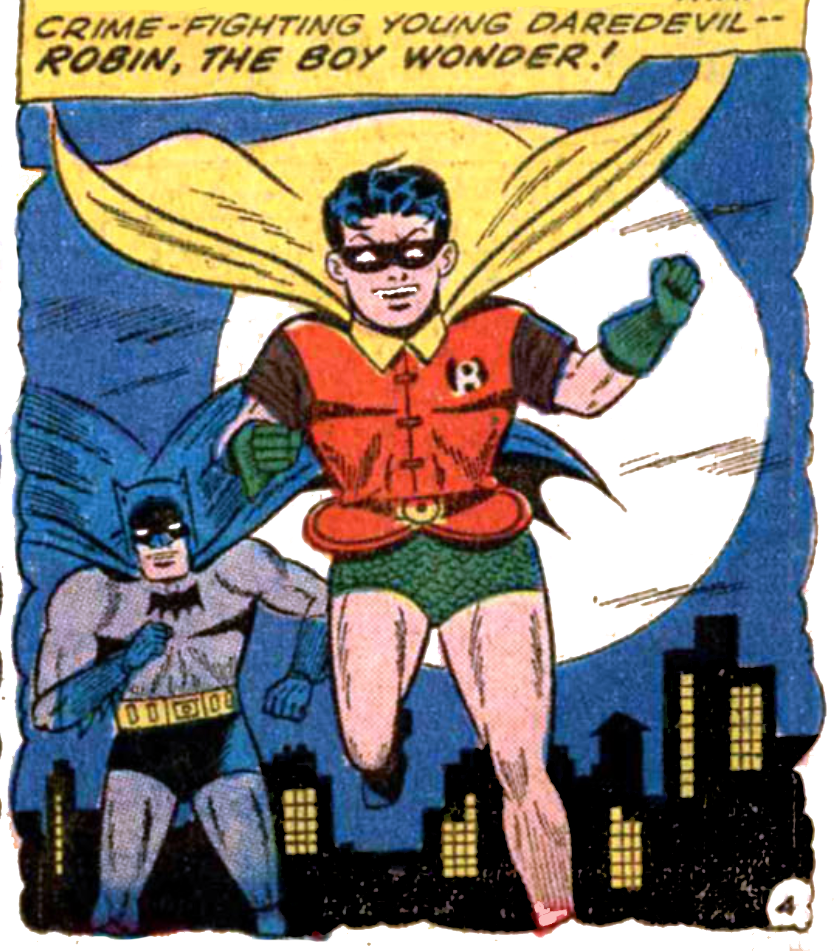
Batman #129 Part 2 by Bill Finger, Sheldon Moldoff, & Charles Paris (1960)
–FLASHBACK: From Batman #129 Part 2. Batman and Robin patrol the city and officially become the scourge of the Gotham underworld—colloquially known as the “Dynamic Duo” almost right from the start.
–REFERENCE: In World’s Finest Comics #168. Batman and Robin make it a rule to always wear their seatbelts when in the Batmobile.
–REFERENCE: In Batman #129 Part 2. Right from the start of his very first patrols with Batman, Robin makes an annoying habit of trying to impress Batman with bad puns while fighting bad guys. The Boy Wonder will be quite the epigrammatist for the rest of his crimefighting career.
–REFERENCE: In Batman #192 Part 2. Batman and Robin assign a secret meeting place in a tunnel in a city park where they should convene for the start of their patrols on nights when they don’t begin at the Batcave. This secret meeting place will be necessary because of both Bruce and Dick’s busy civilian schedules that will interfere with their crime-fighting schedules. For example, Bruce will sometimes have appointments and Dick will have school functions.
–FLASHBACK: From World’s Finest Comics #141. Despite having already officially debuted, Robin’s training with Batman will continue. Batman now works with Robin to further enhance his already strong acrobatic skills.
–REFERENCE: In Detective Comics #457. June 26. Batman begins an what will be an annual tradition on the anniversary of his parents’ deaths. He visits Dr. Leslie Thompkins on Crime Alley.
–REFERENCE: In Detective Comics #344, Batman with Robin the Boy Wonder Daily Newspaper Strip 8/22/1966, Batman with Robin the Boy Wonder Sunday Newspaper Strip 2/26/1967, and Batman #204. Batman and Robin begin learning sign language from an unnamed Native American medicine man. The daily news strip says the sign language teacher is Sioux whereas the Sunday strip says he is Cherokee. But, hey, in 1960s racist-as-hell comic book world, them Indians are all basically they same right? Ugh. Anyway, these lessons will go on for weeks, albeit invisibly on our timeline below. By the end of their lessons, both Batman and Robin will know sign language fluently. Notably, Batman and Robin also come up with their own intra-personal wordless communication system that utilizes only quick finger movements.
–REFERENCE: In Detective Comics #371. Batman and Robin begin learning the challenging lumberjack sport of log-rolling. They will become experts, of course.
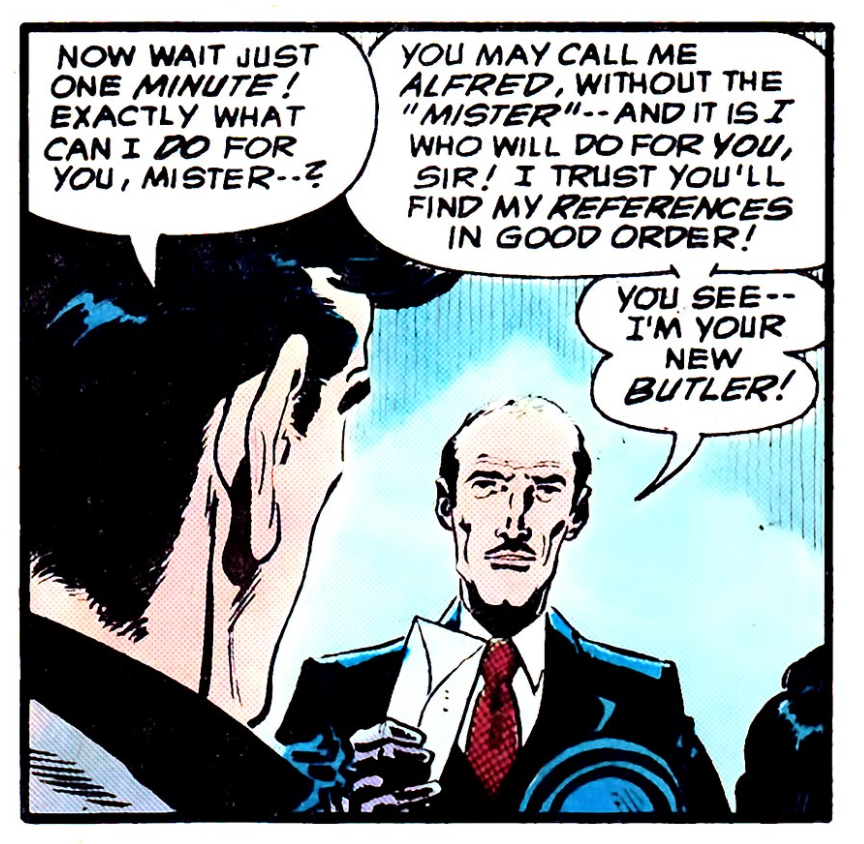
The Untold Legend of the Batman #2 by Len Wein, Jim Aparo, & Glynis Oliver (1980)
–FLASHBACK: From The Untold Legend of the Batman #2—and referenced in Batman #202 Part 1, The Brave and The Bold #141 Part 1, Batman #310, and Detective Comics #501. Ex-British Armed Forces soldier, MI6 spy, trained combat medic, gourmet, and thespian Alfred Pennyworth shows up at the doorstep of Wayne Manor. Alfred explains to a stunned Bruce and Dick that his late father Jarvis was once in the employ of Thomas Wayne as a butler. Alfred offers to continue in his dad’s footsteps, offering his services to the Wayne family. Becoming the new butler of Wayne Manor, Alfred will be in complete charge of the household. He is the quintessential old-school servant—an expert in cooking, care-taking, and housekeeping. With the ring of a bell, he will always come post-haste, eager to serve his “masters.” Bruce sets up Alfred with a hefty salary, full pension plan, and busy but flexible schedule. The new butler of the home will get to know all of Bruce’s personal quirks right out of the gate. Likewise, Bruce and Dick learn all about Alfred’s past, including a bit about his history fighting with the Resistance in Paris during WWII. It’s worth noting that Alfred will handle all of Bruce and Dick’s appointments, invitations, and clerical/scheduling tasks, moving forward. (Therefore, we won’t typically see chronological entries showing Bruce and Dick doing this kind of stuff.)
–REFERENCE: In Batman #191 Part 2, Batman with Robin the Boy Wonder News Strip 2/26/1969, The Brave and The Bold #141 Part 1, and Batman Annual #8. Alfred shows off his talents as a chef, cooking fabulous culinary masterpieces for Bruce and Dick. (Bruce loves everything except for caviar and alcoholic beverages.) Alfred puts his secret recipe files in a safe behind a locked cabinet door. Alfred will cook special meals for Bruce and Dick for decades to come. Notably, Bruce loves Alfred’s steaks (medium rare, of course) and his freshly squeezed orange juice (extra tart, of course).
–REFERENCE: In Detective Comics #386. Because so many instances keep coming up where Bruce’s business and celebrity obligations get in the way of Bat-work, Bruce and Alfred hire a body-double to play Bruce when needed. Bruce’s lookalike, the well-paid Mr. Morse, will have no clue as to what the real Bruce is doing when he is called upon, nor will he ever ask. We can imagine Mr. Morse acting as Bruce, while he is off on a patrol or mission, on many occasions moving forward.
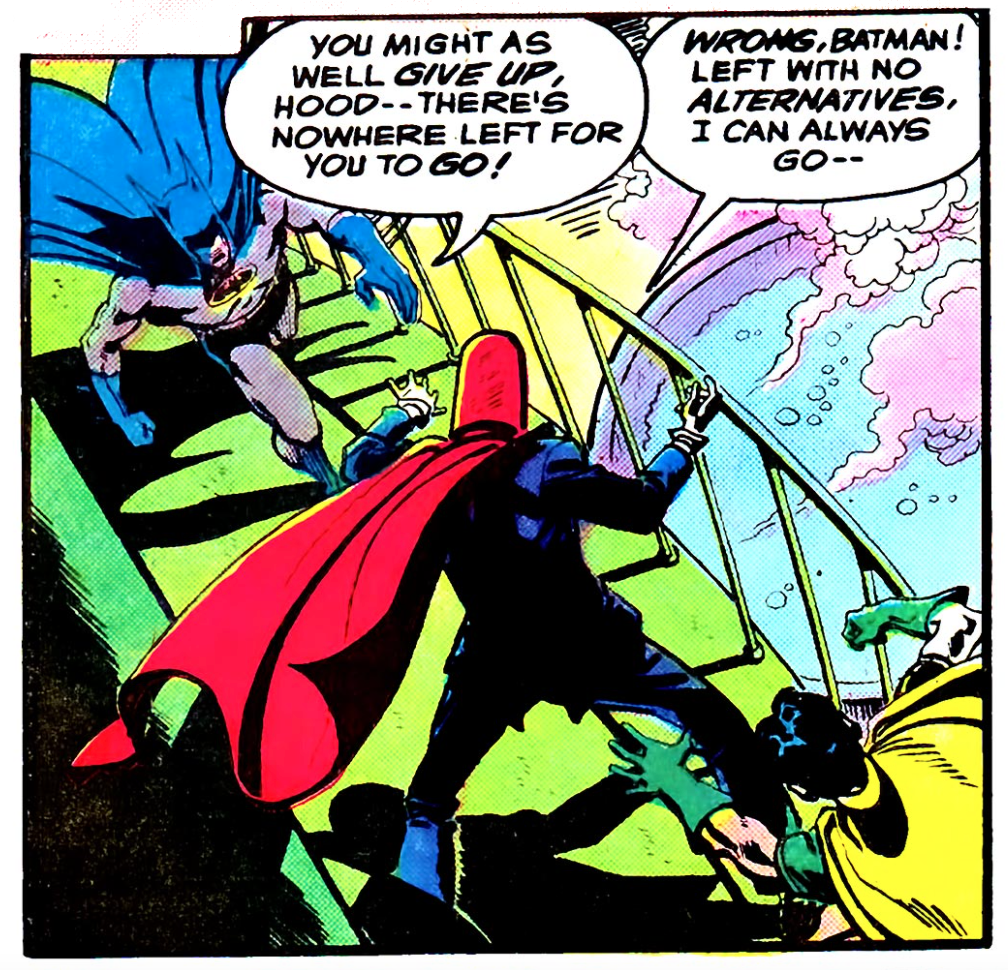
The Untold Legend of the Batman #2 by Len Wein, Jim Aparo, & Glynis Oliver (1980)
–FLASHBACK: From The Untold Legend of the Batman #2 and The Best of DC #14. July 11—the usually-unreliable 1976 Super DC Calendar places this item specifically on July 11, but that actually works perfectly for our timeline. Batman and Robin clash with the criminal known as The Red Hood outside of the Monarch Playing Card Company. During a confrontation with the Dynamic Duo, the Red Hood falls into a vat of toxic chemicals, becoming Joker! Joker immediately debuts and gives the GCPD a bunch of headaches. Likewise, while Batman has yet to meet them, we are told that Catwoman (Selina Kyle) and Dr. Death have both debuted and are running circles around the GCPD. Note that Catwoman is alternately known as “The Cat” at this point.
–FLASHBACK: From The Untold Legend of the Batman #3. After a few more criminals are left tied up with notes on them, Commissioner Gordon finally spots the elusive and mysterious Batman.
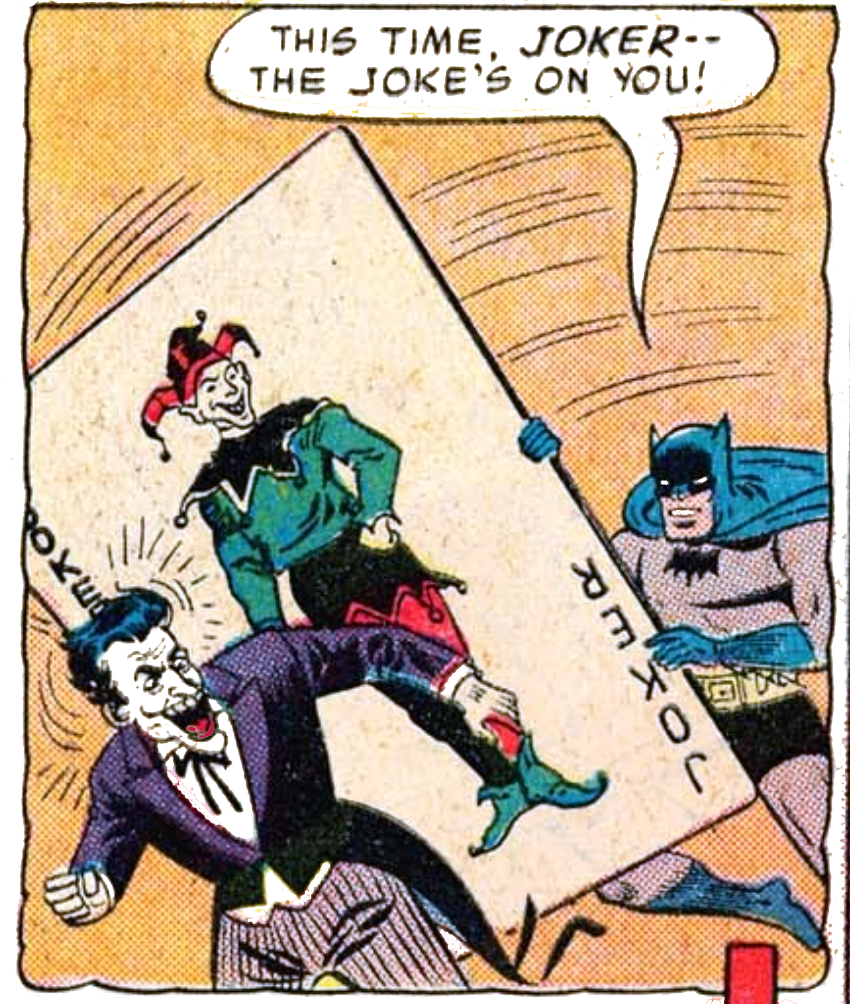
Batman #117 Part 1 by Sheldon Moldoff & Charles Paris (1958)
–FLASHBACK: From Batman #117 Part 1. It has been a few days since Commissioner Gordon viewed Batman in action for the first time. Batman and Robin meet and fight Joker at his gaudy hideout. Batman knocks out the super-villain with a giant playing card. Notably, the fuzzy-canon of the 1976 Super DC Calendar places this item in October, but that’s totally incorrect and must be ignored.
–FLASHBACK: From The Untold Legend of the Batman #3. Batman, having just met and apprehended Joker for the first time, drops him off in front of police HQ.
–REFERENCE: In World’s Finest Comics #122. Batman returns to clean-out Joker’s hideout. He decides to keep Joker’s giant playing card, the reverse side of which displays Joker’s enlarged face. This trophy card goes on display in the currently under-construction Batcave.
–REFERENCE: In Detective Comics #471—originally told in Detective Comics #36. Batman meets, defeats, and jails the vile Dr. Hugo Strange.
–REFERENCE: In Kellogg’s Pop-Tarts Mini Comics #1. Batman constructs a secret tunnel leading from an abandoned house on the edge of his property line into the Batcave.
–REFERENCE: In The Untold Legend of the Batman #2. Bruce and Dick fully finish the Batcave. Batman and Robin then go on a mission at an amusement park and get a huge animatronic Tyrannosaurus rex, which they place into the Batcave as a trophy along with Joker’s giant playing card. From this point forward, Batman and Robin will collect a ton of trophies and add them to their “Hall of Trophies.” Many of the origins of these trophies, specifically a variety of guns, explosive devices, cannons, and stabbing weapons taken from baddies they bust, will not be explicitly shown on our timeline. We’ll just have to imagine Batman and Robin taking a bunch of these trophies during and after each unlisted case. The same goes for random medals and plaques that the Dynamic Duo will receive from this point forward. Notably, the exact arrangement of trophies will be in near-constant flux, thus accounting for myriad artistic liberties that will be taken in conjunction with the display of the trophies in the decades to follow.
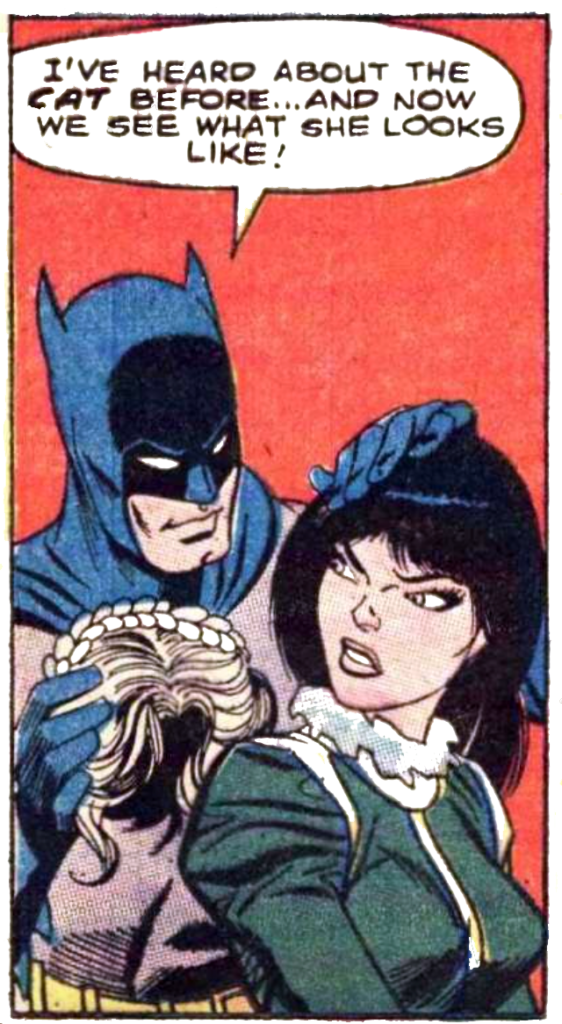
Batman #208 by E Nelson Bridwell, Gil Kane, & Jack Abel (1969)
–FLASHBACK: From Batman #208 and The Best of DC #14—originally told in Batman #1 Part 3. July 28—the date is taken from the 1976 Super DC Calendar, a source which is often wrong but, in this case, is actually right for once. As referenced in The Untold Legend of the Batman #3, the capture of Catwoman (aka The Cat) now takes place, one week after the capture of Joker. Batman and a disguised Robin nab a disguised Catwoman aboard a yacht when she tries to steal a priceless necklace.
–REFERENCE: In World’s Finest Comics #116. Batman and Robin bust “likable” criminal Vance Collins, member of the Jackson Mob. Collins gets served a couple year sentence in prison.
–REFERENCE: In The Untold Legend of the Batman #3 and Batman #345. A week has passed since Batman apprehended Catwoman. Batman now captures Dr. Death, although he never learns his true identity of Dr. Karl Hellfern. Shortly after that, Batman saves Commissioner Gordon’s life. Later, the Dark Knight finally confronts Gordon face-to-face for the first time in the latter’s office. The Caped Crusader convinces Gordon of his well-intentions and they form a partnership. The GCPD takes Batman and Robin off the Most Wanted List.
–REFERENCE: In The Brave and The Bold #170. While the police are cool with Batman and Robin, city government still is not. Thankfully, Batman meets and befriends Ben Marshall, Director of Gotham’s FBI branch. Marshall loves Batman’s work. Marshall meets with municipal government officials, convincing them that Batman is an asset to the city. Sure enough, via Marshall’s intervention, Gotham’s government officials come to approve of the Dark Knight. While Marshall has proven to be quite salutary, Batman and Marshall won’t spend too much time together, moving forward.
–REFERENCE: In Batman with Robin the Boy Wonder News Strip 2/8/1969. Thanks to Ben Marshall, Batman now has a positive relationship with the FBI, who are more than eager to work with him. From the Batcave, Batman sets up a direct wire-photo line (basically a proto-fax machine) through which he can share information and obtain information from the government agency. The FBI promises to help Batman in any way it can, making all of the Dark Knight’s requests “Top Priority.” The FBI will assist Batman here and there, moving forward on our timeline, although most of these instances won’t actually be seen.
–REFERENCE: In Batman Family #11 Part 3. Bruce begins donating money to the GCPD. Bruce will donate money to the GCPD for the rest of his life.
–REFERENCE: From Batman #208—originally told in Batman #3. Catwoman (aka The Cat) escapes custody and strikes again, this time wearing a furry black cat mask that covers her entire head. Batman and Robin defeat her yet again, putting her behind bars. Since we know that Batman nets a catapult as a trophy from an early encounter with Catwoman (as referenced in Batman #94 Part 2), we must assume that it happens here and now.
–REFERENCE: In The Untold Legend of the Batman #1—originally told in Detective Comics #226. Batman receives a package in the mail at Wayne Manor from his old mentor Harvey Harris. The package contains the old proto-Robin costume Bruce wore while training with Harris when he was a boy. A letter accompanying the package explains that Harris had deduced his young protégé was Bruce Wayne. Only in the event of Harris’ death, which has recently occurred, was the Robin costume and letter to be sent to Wayne Manor.
–REFERENCE: In Detective Comics #471-472—originally told in Batman #1 Part 2. Batman and Robin encounter the villainous Hugo Strange, who has escaped from jail. Strange uses his Monster Serum to turn asylum patients into hulking beasts that attack Batman. Batman defeats the “Monster Men” and fights Strange, who takes a dive off a cliff into a river, seemingly dying in the process. (Of course, Strange is fine and we will see him again very soon.)
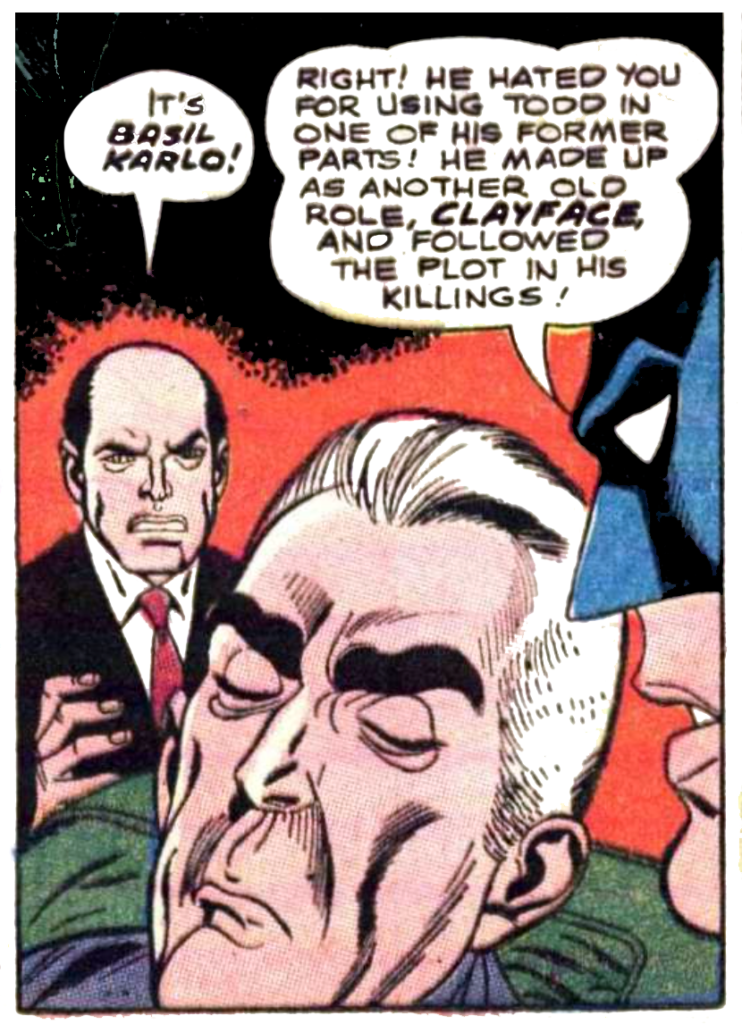
Batman #208 by E Nelson Bridwell, Gil Kane, & Jack Abel (1969)
–FLASHBACK: In Batman #208—and referenced in Detective Comics #496. Originally told in Detective Comics #40. Bruce and Dick visit Julie Madison on the set of a film in which she is the star. When a series of murders occur on set, Batman and Robin quickly swoop in and bust the killer, famous horror actor Basil Karlo (aka Clayface).
–REFERENCE: In World’s Finest Comics #139—originally told in Detective Comics #45. Joker uses the pseudonym of “Rejok” in an attempt to steal a small jade Buddha statue from a Chinese freighter. Batman and Robin stop Joker, netting the jade Buddha as a prize for their Hall of Trophies.
–REFERENCE: In Batman #274. Batman gets a book about African hunting and tracking, which gets added to his extensive Batcave library. He reads about Cameroonian “hand-talking,” a form of sign language used in the bush by hunters while stalking wild game.
–REFERENCE: In Detective Comics #471—originally told in Detective Comics #46. Hugo Strange makes a miraculous return and strikes at Batman and Robin again. And like before, Batman winds up knocking Strange off of a cliff into an ostensible watery grave. However, Strange is indeed still alive, although we won’t see him again for twelve years!
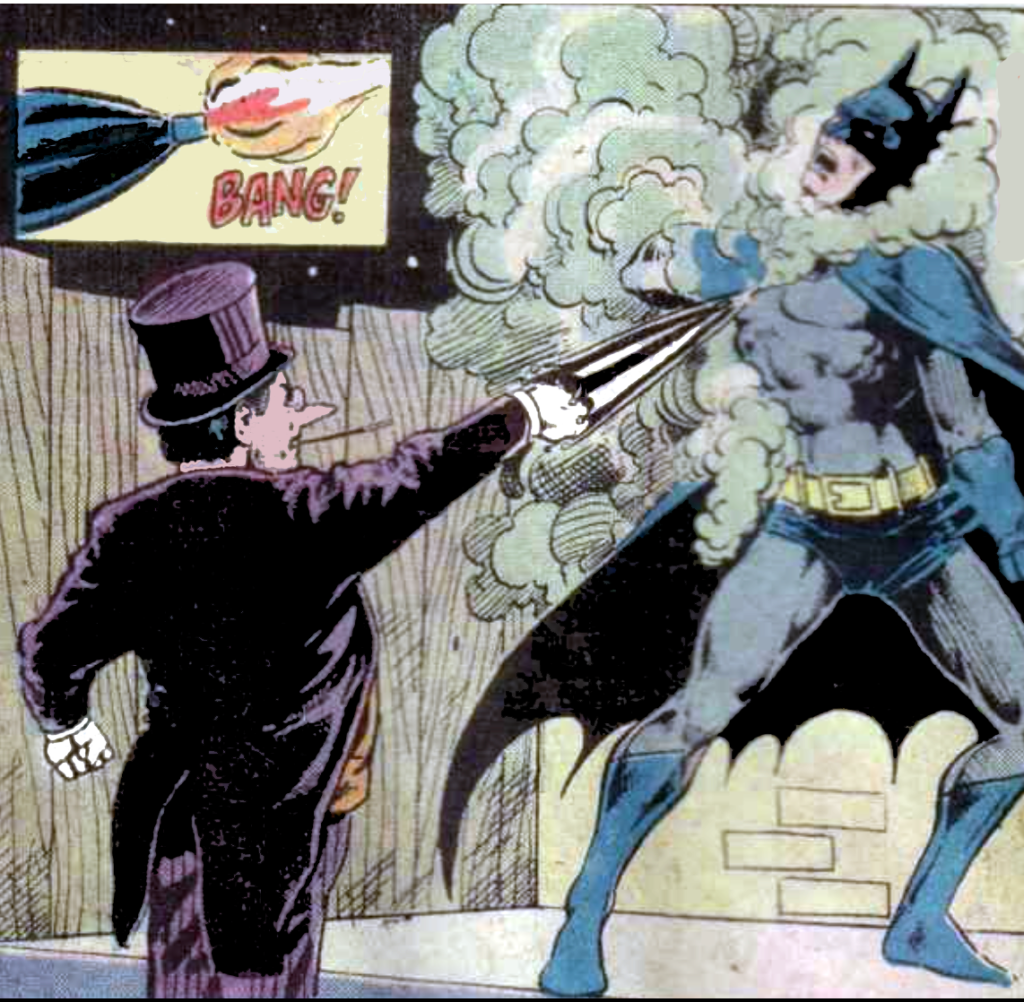
Batman # 257 Part 2 by Julius Schwartz, Denny O’Neil, Irv Novick, & Dick Giordano (1974)
–FLASHBACK: From Batman #257 Part 2—and referenced in Best of DC #10. Originally told in Detective Comics #58. Going by the alias “Boniface,” rookie criminal Penguin (Oswald Chesterfield Cobblepot) kills the head of a large racketeering operation with a machine gun umbrella. After taking over the criminal empire, Penguin starts a huge stealing spree. In his first confrontation with Batman, Penguin doses the Caped Crusader with gas from a trick umbrella, frames the Dark Knight as a thief, then kidnaps him. Eventually, Robin is able to rescue his partner. The Dynamic Duo is recovers the stolen goods and proves Batman’s innocence, but Penguin gets away. Batman puts a giant stuffed penguin and a giant umbrella, commemorating his first fight against Penguin, into the Hall of Trophies (as referenced in World’s Finest Comics #86 and referenced in World’s Finest Comics #122).
–FLASHBACK: From Batman #257 Part 2—and referenced in Batman #99 Part 1 and The Brave and The Bold #166. Batman and Robin immediately have a rematch versus Penguin, who uses a syringe tipped umbrella and a large death trap umbrella against the Dynamic Duo. Penguin evades capture and starts a near-daily war against the Dynamic Duo that will last for the next month-and-half. (In Batman #99 Part 1, which happens roughly one-and-a-half months from now, Batman will say that he’s taken on many Penguin cases. Thus, we must imagine that the ornithocentric villain will constantly spar with the Dynamic Duo in-between listed reference notes and issues from now until Batman #99 Part 1. During these encounters, as seen via flashback from Batman #257 Part 2, Penguin will debut a wide array of different trick umbrellas, including the rear-view mirror, web-shooter, reverse trick gas, parachute, pogo stick, helicopter, and tear gas varieties. As we learn in The Brave and the Bold #166, Penguin will constantly have a variety of pet birds with him wherever he goes. This avian affinity will often lead to Penguin’s downfall as Batman will simply shake down rare bird importers and pet shops to stay hot on his trail. (Whenever Penguin is around, moving forward, a visit to the pet store will usually be in order.) Again, these Penguin-related encounters will occur randomly scattered throughout the next month-and-a-half, but we must simply imagine them on our timeline below.
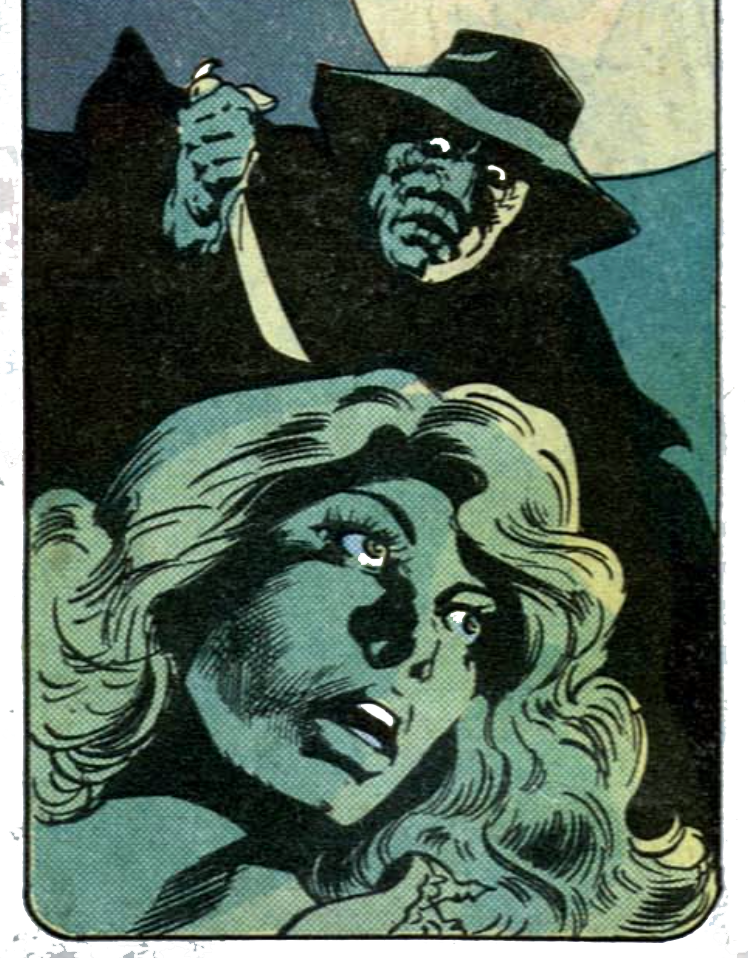
Detective Comics #496 by Michael Fleisher, Don Newton, Dan Adkins, & Adrienne Roy (1980)
–FLASHBACK: From Detective Comics #496—and referenced in Batman #208 and World’s Finest Comics #248 Part 1. Originally told in Detective Comics #49. Studio executives convince Julie Madison to change her name to the more exotic “Portia Storme.” Portia is heralded as Hollywood’s next big star. Disillusioned with with Bruce and disheartened with his lackadaisical Playboy lifestyle, Portia dumps Bruce, calling off their engagement! Meanwhile, Clayface (Basil Karlo) escapes from a prison transport and attempts to kill Batman, Robin, and Portia. The Dynamic Duo defeats Clayface, who winds up behind bars. In the end, Portia leaves Gotham, becomes a famous celebrity, and quickly marries the King of Moldacia in a lavish televised royal wedding, becoming Princess Portia of Moldacia. (Moldacia is also spelled “Moldachia.”)
–REFERENCE: In Crisis on Infinite Earths #2. Bruce begins watching The Prisoner on TV.
–REFERENCE: In Detective Comics #359. Jim Gordon introduces his thirteen-year-old daughter Barbara “Babs” Gordon to Bruce Wayne. Bruce regards her as a mousey type, not thinking much of her. He will think of her that way for years. Bruce and Babs will encounter each other via Jim for years to come, but we won’t see these encounters listed on our timeline.
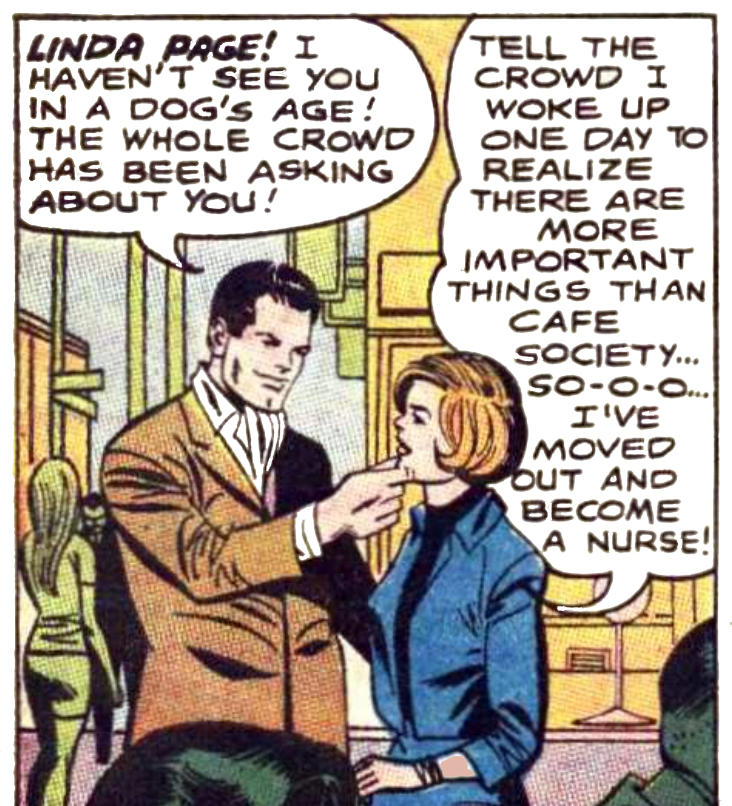
Batman #208 by E Nelson Bridwell, Gil Kane, & Jack Abel (1969)
–FLASHBACK: From Batman #208—originally told in Batman #5 Part 4. Batman runs into his old cafe society friend Linda Page, who has become a full-time registered nurse. When the notorious Grogan Brothers, Mike and Tommy, hold-up a bank, the Caped Crusader goes to question Linda upon discovering that she was once good friends with them. At Linda’s downtown pad, the Dark Knight discovers that she has apparently been taken hostage by the villainous brothers. Batman and Robin rescue Linda and bust Mike, who was solely responsible for the crime. Afterward, Tommy goes straight, having learned his lesson. Bruce then begins dating Linda.
–REFERENCE: In Batman Annual 1986 Part 4—originally told in Batman #9 Part 2. Batman and Robin scuffle with pirate cum human-trafficker Captain Burley only to team-up with him against the greater threat of insurance-scammer Mr. Radney, who operates a submarine disguised as a giant white whale. Burley and Radney wind up killing each other. After this case wraps, Batman puts a harpoon cannon into the Hall of Trophies.
–REFERENCE: In Batman #308—originally told in Batman #15 Part 1. Bruce hosts a beauty pageant and meets “Elva Barr”—actually an escaped and disguised Catwoman. This is the first time she really interacts with Bruce (instead of Batman), falling head over heels for him. After Bruce switches to Bat-mode and stops Catwoman’s plan to rob the wedding of a celebrity involved in the pageant, she convinces Batman to let her go by saying she’d go straight for Bruce. Bruce enacts an elaborate ruse that involves dating and even proposing marriage to “Elva.” The two become very close, so who’s to say what’s real and what’s faked here. Eventually, after things get quite messy (don’t forget Bruce is already dating Linda Page), “Elva” quickly returns to crime and quickly gets busted by Batman.
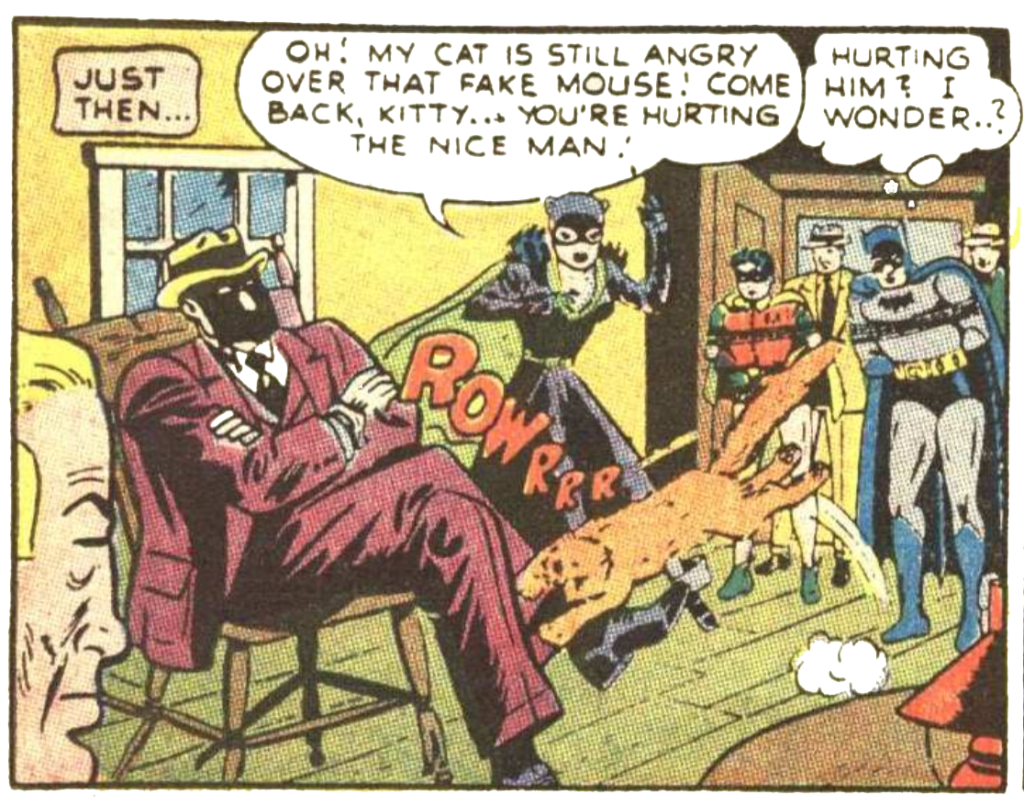
Batman #208 (Batman #62 Part 1 reprinted as flashback) by Bill Finger, Bob Kane, Lew Sayre Schwartz, & Charles Paris (1950, reprinted 1969)
–FLASHBACK: From Batman #208 and Batman Family #17—originally told in Batman #62 Part 1 and Detective Comics #203. Super-villain Mr. X breaks Catwoman out of the slammer and recruits her into the fold. Batman and Robin capture Catwoman, who initially eludes the Dynamic Duo but backtracks to save the Dark Knight’s life from a collapsing building. During the implosion Catwoman is knocked unconscious. Batman nurses Catwoman back to health in the Batcave and when she awakes, she finally reveals her true identity as Selina Kyle. Not only that, Selina claims that she has had a split-personality disorder for the entire duration of her criminal career. Naturally, Batman, Robin, and Commissioner Gordon buy this cockamamie story and pardon Selina for all of her previous crimes.[6] Catwoman then helps Batman and Robin bring Mr. X and his gang to justice. Afterward, Selina retires from costumed chicanery. But, Catwoman’s plan to get a clean record and live happily ever after doesn’t last very long. Shortly thereafter, an insulting article is printed in the Gotham Gazette that pokes fun of her crimes as Catwoman. Enraged, Selina re-dons her costume and commits a series of daring public heists, ruining her clean “amnesia” record and officially becoming a super-villain again. (Note that the Batman Family #17 flashback simply shows Batman and a purple-costume-wearing Catwoman working together, so it has to be this story. The Batman Family #17 flashback contradicts the Batman #208 flashback by showing Batman in his yellow oval costume. That is likely a mistake.)
–FLASHBACK: From Detective Comics #280. Batman busts thief Paul Strobe, who has robbed his business partners Henry Hayes, Barker, and Jenkins. Batman, Hayes, Barker, and Jenkins all testify in court. Strobe is sentenced to a short term, but vows revenge.
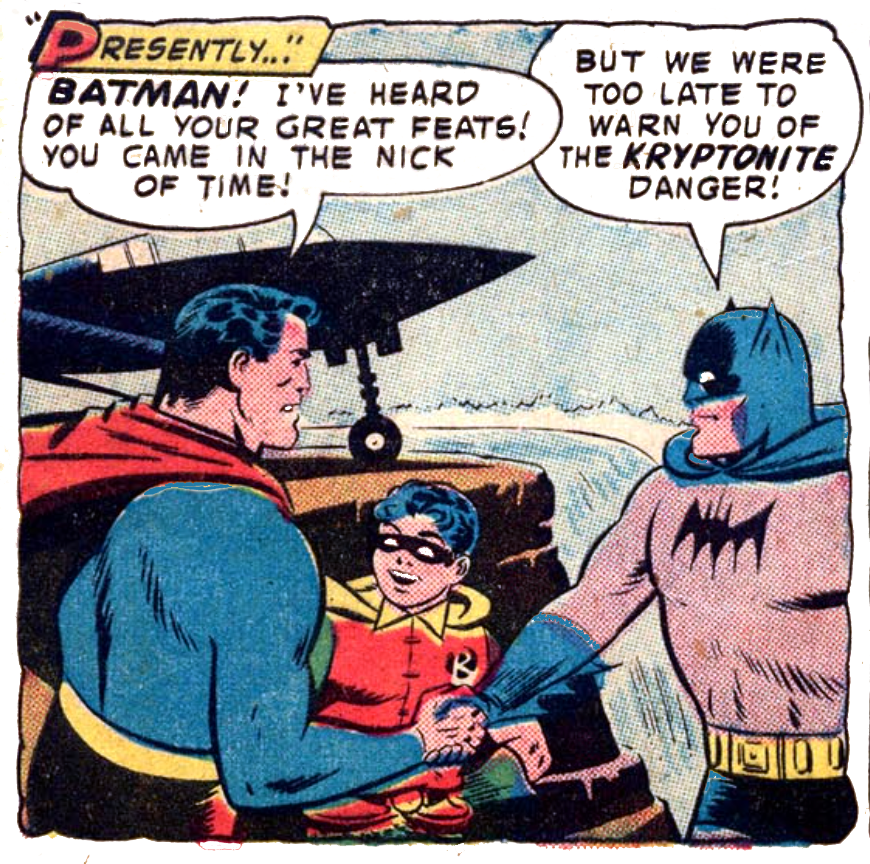
World’s Finest Comics #94 by Edmond Hamilton, Dick Sprang, & Stan Kaye (1958)
–FLASHBACK: From both World’s Finest Comics #94 and World’s Finest Comics #271. Batman and Robin study-up to learn all they can about the world’s most famous superhero, Superman. (Superman is Kal-El, the former Superboy who is a now all-grown-up “Man of Steel”.) Part of the Dynamic Duo’s Super-study includes learning more about Superman’s biggest publicly known weakness: Kryptonite, radioactive green meteorite chunks that have landed on Earth from the Man of Steel’s destroyed home-world of Krypton. (Kryptonite being Superman’s weakness has been public knowledge since his days as Superboy.) Batman and Robin bust some crooks that mention their accomplices have gotten hold of some Kryptonite in Superman’s hometown of Metropolis. Batman and Robin take a trip to Metropolis just in time to see some baddies spray Superman with liquid Kryptonite. The Dynamic Duo saves Superman and washes off the green goop. Afterward, Batman and Robin meet Superman for the first time and vow to partner up as a trio! Batman disguises himself as Superman and confronts the villains, who spray him with Kryptonite to no effect. The real Superman then gets the jump on the confused evildoers and takes them down.
–REFERENCE: In World’s Finest Comics #164, World’s Finest Comics #249, World’s Finest Comics #285, and Action Comics #262. Superman and Batman share a cup of coffee and get to know each other better. (While we won’t physically see them on our chronology, WFC #285 tells us that the “World’s Finest” will share hundreds of cups of coffee by 1982, so we must imagine superhero coffee breaks happening with some frequency on our timeline ahead.) As referenced in WFC #164 and WFC #249, we can imagine a coffee chat here and now in which Superman shares his personal values with the Dynamic Duo, verifying that he too has a strict no killing code when it comes to handling the war on crime. Superman also tells Batman that, under no circumstances, will he ever accept money to provide assistance to corporations or private entities. We can also assume that this conversation is also where Batman learns that Superman’s powers come from the rays of Earth’s white sun (i.e. yellow dwarf sun).
–REFERENCE: In World’s Finest Comics #289. Batman is tempted to reach out to Superman to ask him to permanently wipe out every Gotham criminal in one fell swoop. Seeing that this would be irrational and despotic, Batman refrains from reaching out. However, in his darkest and most frustrated moments of vigilantism, Batman will often think of how easily Superman could clean up Gotham with an iron fist.
–REFERENCE: In Batman Family #12 Part 1—originally told in World’s Finest Comics #53. When gangster Dave Ravage targets Commissioner Gordon, Batman goes in-disguise as Gordon. Batman meets Gordon’s ex-wife Barbara Gordon and his nineteen-year-old son Tony Gordon. The Dark Knight gets the jump on Ravage and busts him. (As seen via flashback in Batman Family #12 Part 1, Tony will soon go missing while ballooning over China. Believed to be dead, Tony will spend the next twelve years in a Red Chinese prison!)
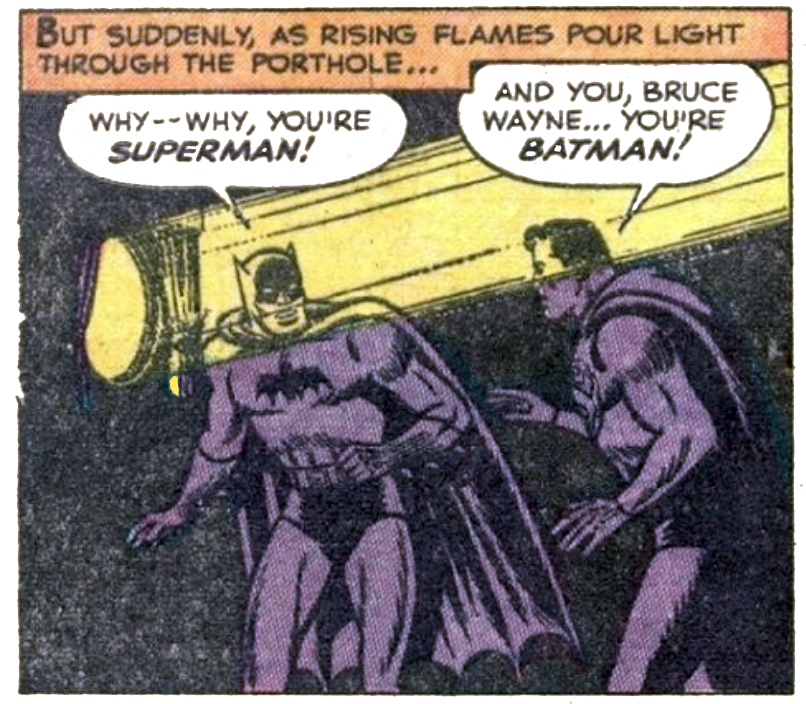
Superman #76 by Edmond Hamilton, Curt Swan, Stan Kaye, & John Fischetti (1952)
–Superman #76[7]
A flashback from World’s Finest Comics #271, which shows Superman #76, retroactively made Superman #76 the definitive Earth-1 Batman/Superman story where they learn each other’s secret IDs. Superman #76 is not canon on Earth-2—only on Earth-1. Onto a synopsis. After capturing the criminal Gell on behalf of Commissioner Gordon, Batman and Robin return home. Dick goes on vacation upstate to visit his relatives while Bruce takes his own vacation aboard the cruise ship Varania. As fate would have it, Daily Planet reporter Clark Kent is also going on vacation aboard the Varania and is made Bruce’s roommate! Clark is actually Superman. (Obviously.) When a diamond thief sets fire to the docks, Bruce and Clark are forced to change into their superhero togs, revealing their secret IDs to each other! On the docks, Batman not only meets intrepid young reporter Lois Lane, but saves her life! With the crook and diamonds hidden aboard the ship somewhere, Lois joins Bruce and Clark on the trip. Batman and Superman team-up for the first time ever to investigate the crime, all the while playing bizarre mind games with Lois and doing performances for the cruise-goers. Eventually, Batman and Superman nab the villain, John Smilter. Later, with Lois suspicious that Bruce and Clark might be the World’s Finest duo, Superman flies Batman at super-speed to he can make a public appearance in Gotham and shoots him right back to the ship so he can show himself off as Bruce. Bruce then disguises himself as Clark so that Superman can fool Lois even more. Upon returning to the docks, Lois meets Robin. The SS Varania episode is also shown via flashback from World’s Finest Comics #71.
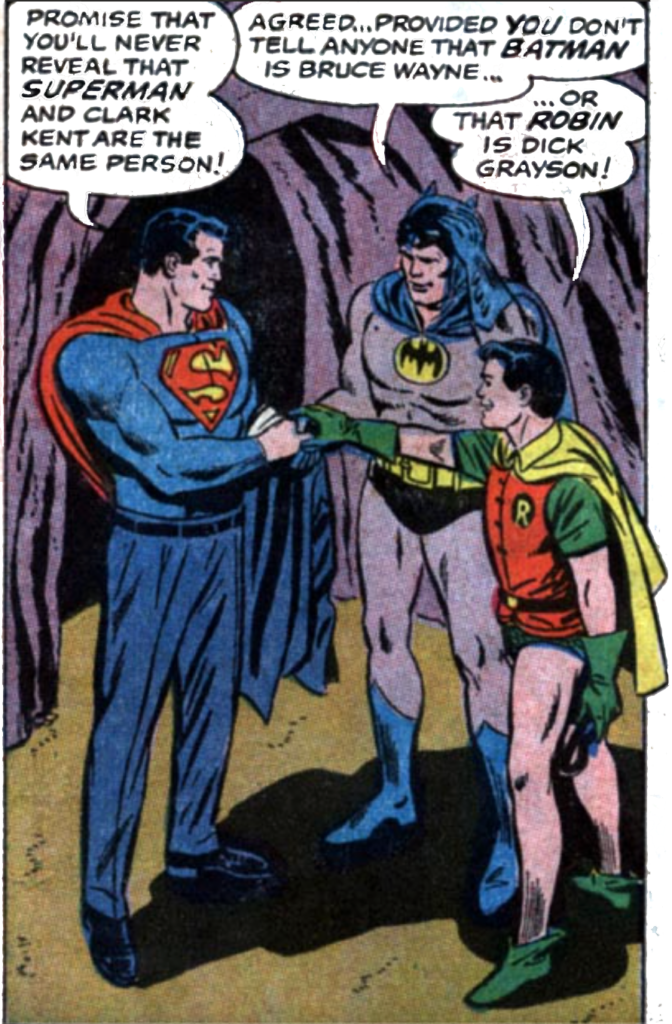
Action Comics #365 by Leo Dorfman, Ross Andru, & Mike Esposito (1968)
–FLASHBACK: In Action Comics #365—and referenced in Action Comics #241, Action Comics #375, World’s Finest Comics #240, and World’s Finest Comics #319-320. Superman allows Batman to share his secret ID with Robin. (In the Action Comics #241 reference, Batman mistakenly says that he and Superman first “shared” each other’s secret IDs with one another. Obviously, this is wrong. They didn’t share—they found out each other’s IDs by accident on the cruise ship Varania.) Batman and Robin then show off the Batcave to Superman for the first time and Superman shows the Dynamic Duo the Fortress of Solitude for the first time. The Man of Steel shows the Dynamic Duo his giant key—camouflaged as an airplane marker in the snow—that opens the Fortress gate. He also shows them the security system and all its features. Batman is in complete awe of every aspect of Superman’s Fortress, including the interplanetary zoo. Batman will be in awe every time he visits, moving forward.
–REFERENCE: In World’s Finest Comics #155-156 and Action Comics #375. Batman and Superman team-up on an unspecified case. Now that they are fully acquainted, the Dark Knight and the Man of Steel will go on tons of cases together, the majority of which we simply will not see on our chronology. We won’t see them because they’ve never been written about, only referenced. Specifically, Batman and Superman, by early Year Seven, will have gone on 1000 cases together. We can infer from this information that, beginning now and moving forward, the World’s Finest Duo will combine forces to go on a whopping roughly 180 cases a year. Basically, just imagine that Batman and Superman hang out pretty much constantly in-between our official bulleted chronological items. Also note that Superman immediately begins keeping a numbered catalogue of all the cases that he goes on with Batman. Note that the Man of Steel will keep at least one trophy after every single one of these future team-up adventures, many of them bizarre tech items that might not even directly relate to the cases they get involved in. Batman won’t keep quite as many trophies as Superman does, but he does now add a special “Superman Souvenir” corner to his Hall of Trophies, in which he will place gifts from Superman or trophies that are specific to Superman-related cases. The first item to go into the “Superman Souvenir” corner is a map of the Arctic, detailing the location of the Fortress of Solitude.
–REFERENCE: In Justice League of America #141. Global news media coins the term “World’s Finest” in reference to the team of Batman and Superman. This nickname will stick for decades to come.
–REFERENCE: In World’s Finest Comics #232. Superman tells Batman and Robin that he doesn’t need to sleep like humans do.
–REFERENCE: In Batman #267. Batman learns about the inner-workings and procedures of the Gotham Fire Department.
–REFERENCE: In Batman #340. Batman sets up a fake animatronic Batman dummy that can be activated to give the impression that the Dark Knight is running around outside of Wayne Manor. This Bat-dummy is to potentially fool folks in the very specific situation where Bruce would need to prove he isn’t Batman to someone inside Wayne Manor. I guess cover all your bases, right?
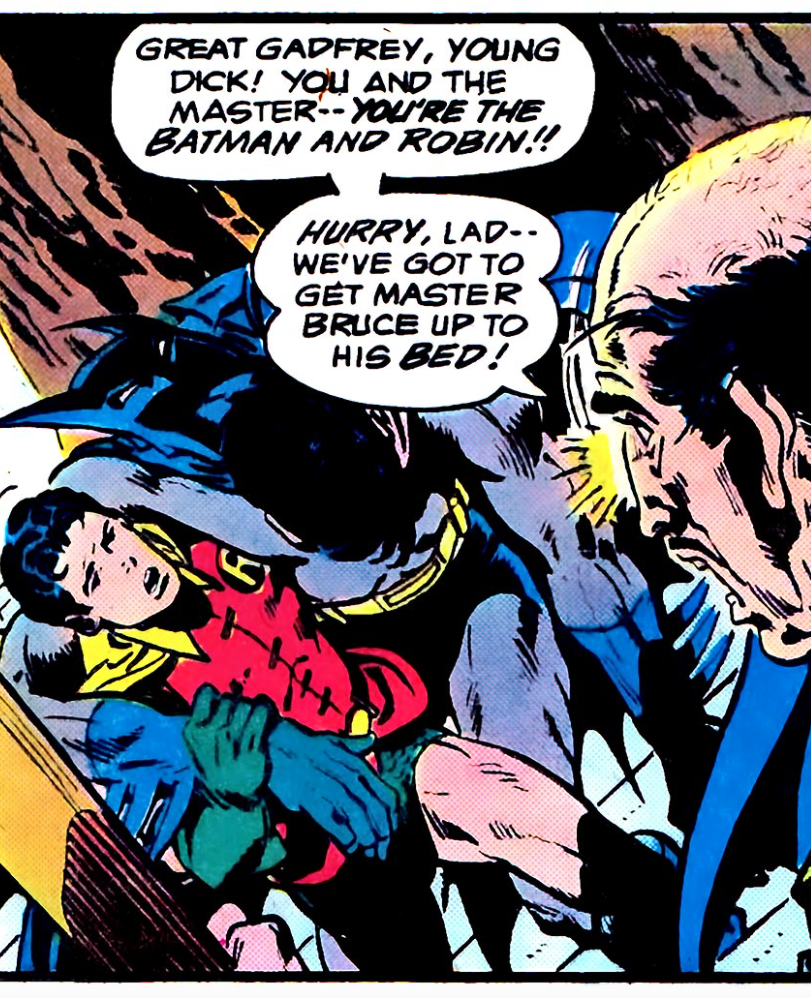
The Untold Legend of the Batman #2 by Len Wein, Jim Aparo, & Glynis Oliver (1980)
–FLASHBACK: From The Untold Legend of the Batman #2. Several weeks have passed since the debut of Alfred Pennyworth. On this fateful night, Alfred awakes to the sound of someone calling his name from the bowels beneath Wayne Manor. A nervous Alfred follows the noise through the secret passageway behind the grandfather clock and winds up smack dab in the middle of the Batcave. There, Batman and Robin have just returned from routine patrol, but the Caped Crusader is badly injured. Alfred is stunned to learn the secret of secrets. After regaining his composure, Alfred performs surgery and saves the Dark Knight’s life. Entrusted with the knowledge of the Dynamic Duo’s secret identities, Alfred becomes a loyal member of the Batman Family aka Bat-Family.
–REFERENCE: In Detective Comics #383, Detective Comics #457, Detective Comics #510, Batman #263, and Batman #310. Alfred begins packing sandwiches and coffee in the Batmobile for Batman and Robin’s nightly patrols. He will do so, moving forward. Likewise, Alfred begins preparing a hot breakfast for the boys, which he will regularly serve when they return home from extra late patrols. These meals will always include soup, main course, and a beverage. Batman’s favorite is Eggs Benedict and coffee. If there isn’t enough time for a real meal, Alfred will substitute a high-protein energy shake (to go) instead.
–REFERENCE: In Batman with Robin the Boy Wonder News Strip 8/15/1967 to 8/17/1967. Batman gives Alfred the key required to activate the self destruct mechanism on the secret Batmobile entrances to the Batcave.
–REFERENCE: In Detective Comics #237 and Detective Comics #367. Bruce has last will and testament written out by his unnamed attorney. He makes Dick and Alfred the primary and secondary beneficiaries.
–REFERENCE: In Detective Comics #434. Batman begins teaching Alfred about police work. Alfred already has a strong espionage and military background, but thanks to Batman’s guidance, he will become an expert detective in his own right.
–REFERENCE: In Batman #99 Part 2 and Detective Comics #405. Batman states publicly that he has never used a gun in his war on crime and he never will. Despite this, Batman, feeling that he should be an expert in all things, begins taking shooting lessons and doing target practice in an effort to understand the thing he hates the most in the world. Batman’s anti-gun vow stands, and he’ll never use a firearm against another living person, but if he needs to use a gun for some other reason, he’ll know how. From time to time, moving forward, Batman will let it be known, as a reminder, that he hates guns. In the future, Batman will unfortunately kill animals (and sometimes with a firearm), but only as a last resort. Don’t forget, while he ain’t vegan, Batman is a huge animal lover, who even frowns upon hunting for sport.
–FLASHBACK: From Batman #165 Part 2. October 31—Halloween. Precocious teenage college student Patricia “Pat” Powell, hoping to meet her mega crush Bruce Wayne, dons a pirate costume and trick-or-treats at Wayne Manor. Sure enough, Pat meets Bruce, although Bruce cannot see her face thanks to a pirate mask.
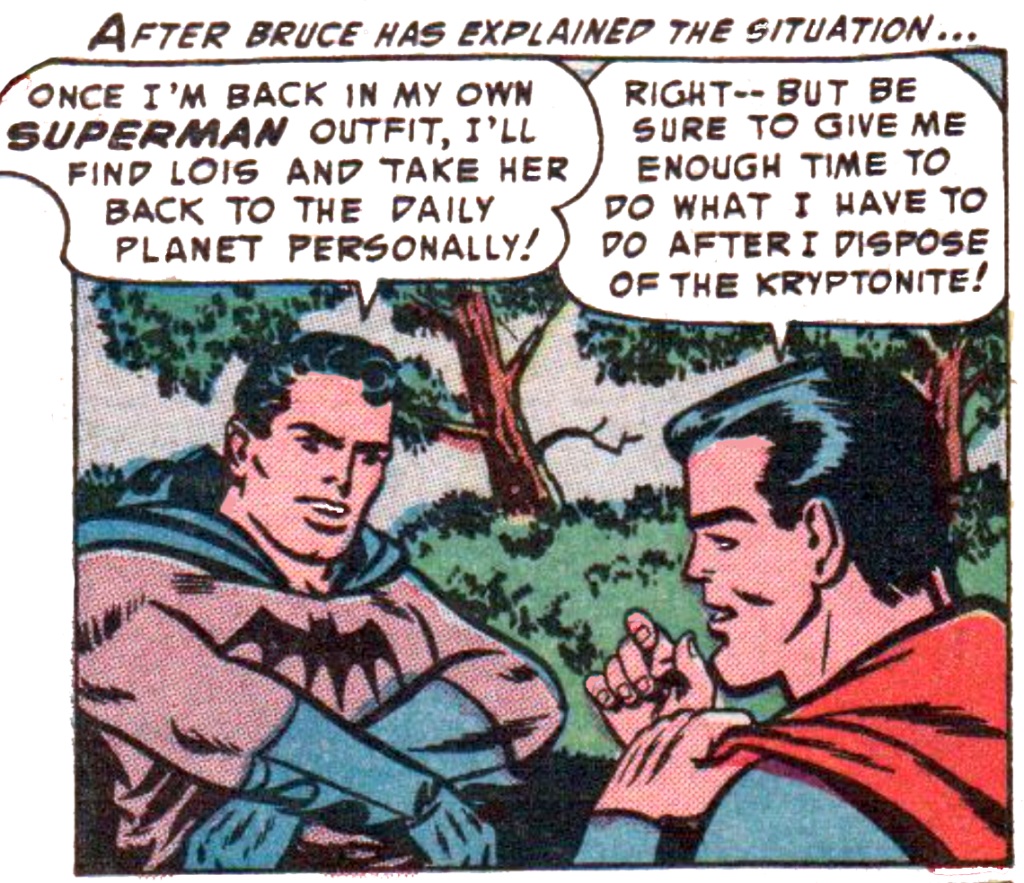
World’s Finest Comics #71 by Alvin Schwartz, Curt Swan, & Stan Kaye (1954)
–World’s Finest Comics #71[8]
WFC #71 is said to take place “many months” after Superman #76, but due to the compression of the added-in Golden Age stories (like this one) into this first year, WFC #71 must occur less than a month after Superman #76 instead. Batman and Robin travel to Metropolis where they engage with bad guys that have retrieved a chunk of Kryptonite from the ocean. The baddies use a military helicopter to shoot down the Batplane, prompting Superman to rescue the Dynamic Duo. However, Lois Lane sees Clark change into his Superman costume, so Batman and Superman decide to switch roles in order to fool her. While Superman (dressed as Batman) gets knocked-out by Kryptonite, Batman (dressed as Superman) uses a plethora of tricks—including punching out trained timid lions, putting glue in his hair to make it “unbreakable,” lifting inflatable “heavy” objects, and “flying” with the assistance of hot air balloons—to fool Lois. After a few days, Batman (still dressed as Superman) takes down the crooks responsible for defeating Superman. Meanwhile, Lois finds the down-and-out Man of Steel (who is still wearing a Batman costume). After some more trickery, Lois is so confused as to who is who that she comes to believe that neither man can possibly be a superhero at all. (This episode is also shown via flashback from World’s Finest Comics #271.)
–REFERENCE: In Batman #215. Bruce is scheduled to appear at an event alongside Batman. Alfred dresses up as Batman so that both Bruce and Batman can attend. While not specifically shown on our timeline, either Alfred or Superman will play the role of Batman for future situations similar to this.
–FLASHBACK: From World’s Finest Comics #81. Batman and Robin are first to detect a massive tornado (i.e. hurricane) heading toward the Eastern Seaboard. They alert Superman, who manages to spin the hurricane back into the sea.
–FLASHBACK: From World’s Finest Comics #76. Gotham’s Mayor Alan Dent[9] and the Gotham City Council campaign against the Metropolis City Council for the rights to host the upcoming World Electronics Convention. Outside the Gotham Convention Center, the heads of the city councils meet with Superman, Batman, and Robin. It is decided that, at a date to be determined, Superman will switch places with the Dynamic Duo for a 24 hour period. During that time, whoever completes more “civic-service exploits” will win the rights to hosting the World Electronics Convention for his home city.
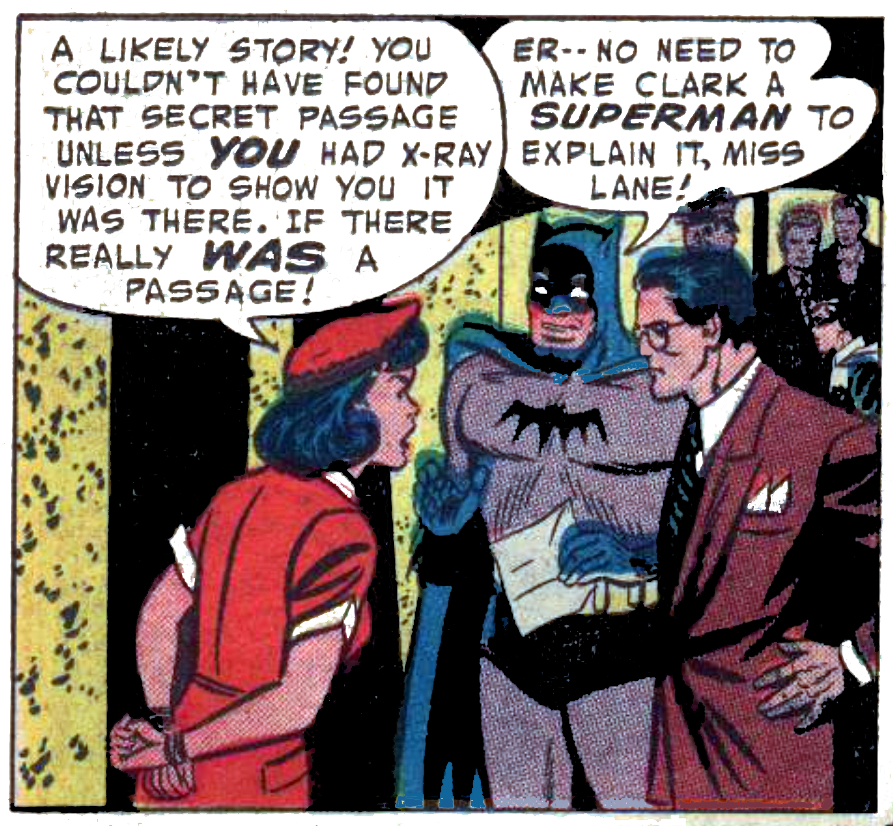
World’s Finest Comics #72 by Alvin Schwartz, Curt Swan, & Stan Kaye (1954)
–World’s Finest Comics #72[10]
When the Heavy Weapons Gang, which uses anti-tank guns to smash up armored cars—previously stopped by Superman in Metropolis—shows up in Gotham, it’s Batman and Robin’s turn to beat them up. Batman, Robin, Clark Kent, and Lois Lane go to a Metropolis prison’s Death Row to interrogate two of the nabbed gangsters. (Clark has been sent there by his boss at The Daily Planet, Editor-in-Chief Perry White.) After the Dynamic Duo departs from the prison, the gangsters pull off a daring escape and take Clark and Lois as hostages. Despite being unable to change into Superman, Clark discreetly uses his powers to alert Batman and Robin to their location, inside a huge stone fortress. Unlike Superman of later comic book ages, the Silver Age/Earth-1 Superman can use his x-ray vision not just to see through things, but also as a type of “telekinesis vision.” This early version of “tactile telekinesis” is shown in WFC #72 as Clark types a typewriter and throws rocks using his eyeball power. Superman eventually joins Batman and Robin to defeat the crooks. Lois accuses Clark of being Superman, but Batman throws her off the trail. Later, in the Batcave, Superman reassembles the Heavy Weapons Gang’s gun-making machine for the trophy room.
–REFERENCE: In World’s Finest Comics #76. Commissioner Gordon starts using the Bat-Signal to summon Batman. (The Bat-Signal is also spelled “Batsignal,” “Bat-signal,” or “Bat Signal”.) When the Bat-Signal is turned on, an alarm goes off in the Batcave as well. Furthermore, via a one-way radio communicator, the GCPD can send detailed recorded information to Batman directly in the Batcave (as referenced in Batman #152).
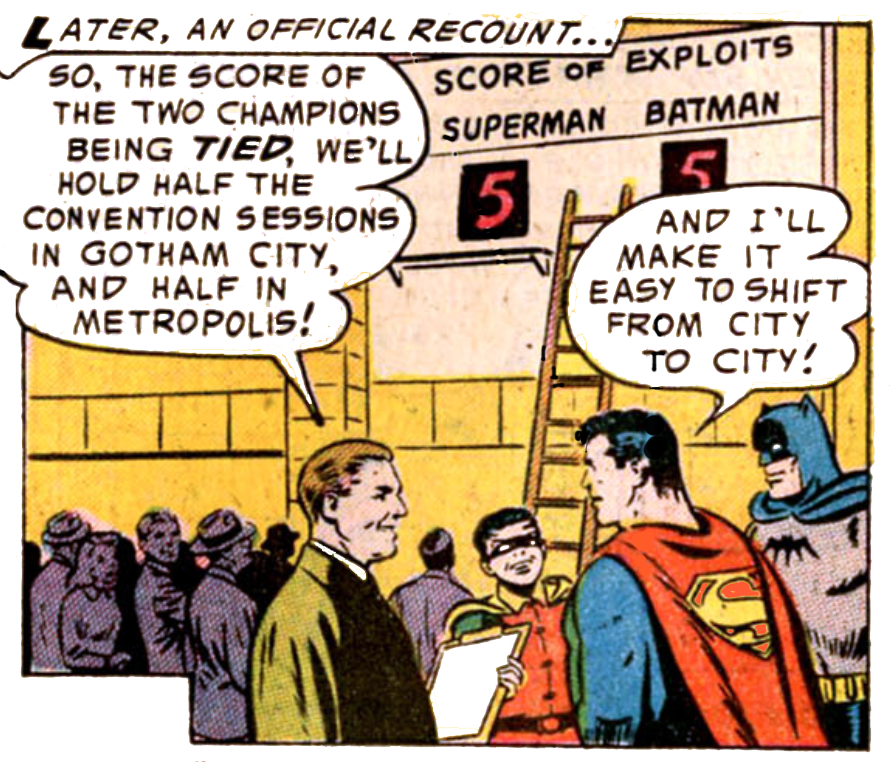
World’s Finest Comics #76 by Edmond Hamilton, Curt Swan, & Stan Kaye (1955)
–World’s Finest Comics #76[11]
This item takes place “weeks” after the flashback where opposing city councils decided to pit Batman versus Superman. As stated, the respective city councils of Gotham and Metropolis decided their hometown heroes should switch places for 24 hours in order to contest for the right to host the World Electronics Convention. Now that day has come. Whoever can complete more “civic-duty exploits” will win the contest. In Gotham, Superman completes four exploits: Busting some helicopter crooks, dealing with a broken gas main, quelling a thunderstorm by holding a lightning rod, and building a Founding Fathers Memorial. In Metropolis, Batman alters the Superman-Signal atop the Metropolis Police Department building into a Bat-Signal and begins his day. The Dynamic Duo busts some crooks at the ice ballet, catches an escaped convict, stops a gangster in a tank, removes the damaged cars from the tank battle, and then performs a circus routine for charity. Batman and Robin win 5 to 4! But why was Batman trying so hard? Because a scientist is bringing a new device that emits Kryptonite rays to the convention. Later, Superman then reveals to Lois that he fixed some potentially dangerous damage in the Batcave ceiling, which should have tied the score at 5. Superman flies to Gotham and immediately loses his energy when he nears the K-machine. Thankfully, the machine malfunctions and falls apart. With the score tied, it is decided that the convention should take place in both cities. After a few hours in Gotham, Superman literally lifts the convention center off of its foundation and flies it to Metropolis.
–REFERENCE: In World’s Finest Comics #77. Batman, Superman, and Robin take on the debuting super-science-villain known as Professor Pender.
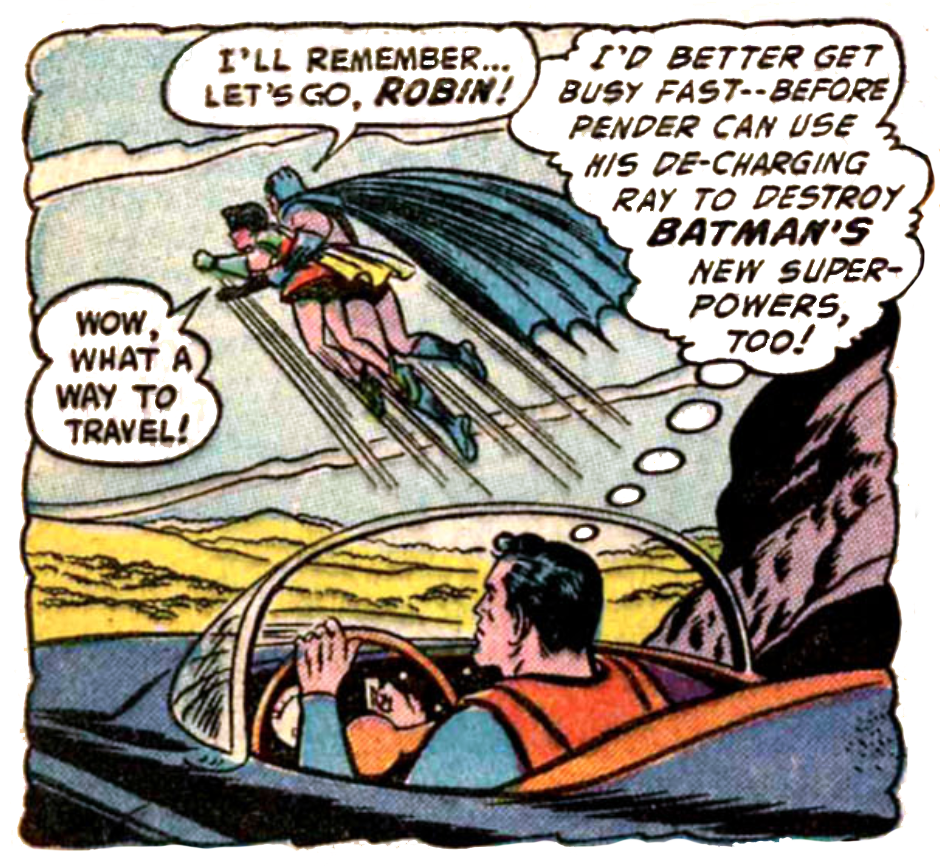
World’s Finest Comics #77 by Edmond Hamilton, Curt Swan, & Stan Kaye (1955)
–World’s Finest Comics #77-78[12]
Superman, Batman, and Robin attack Professor Pender in Metropolis. The science-villain tries to zap himself with a newly invented machine of his own design, but accidentally zaps Batman instead. Before the machine is destroyed, the Dark Knight is endowed with all of Superman’s powers for 24 hours! Pender grabs the machine’s power tube and shoots Superman with a “de-powering ray.” (In actuality, Pender has doused Superman’s costume with Kryptonite dust, making him extremely tenuous and powerless). With Superman rendered powerless, Super-Batman soups up the Batmobile as a Supermobile and fashions a Supercave for him. While the impotent Superman bluffs crooks in Metropolis, Bruce adjusts to his superpowers at Wayne Manor and then performs Superman-esque feats all over Gotham. Eventually, Superman realizes that the K-dust is on his costume, switches into a clean uniform, and regains his strength. Superman, Super-Batman, and Robin then bust Pender and smash up his power tube, which can never be replicated apparently. Afterward, Lois seems convinced that the heroes did a simple costume switcheroo (as they love to do).
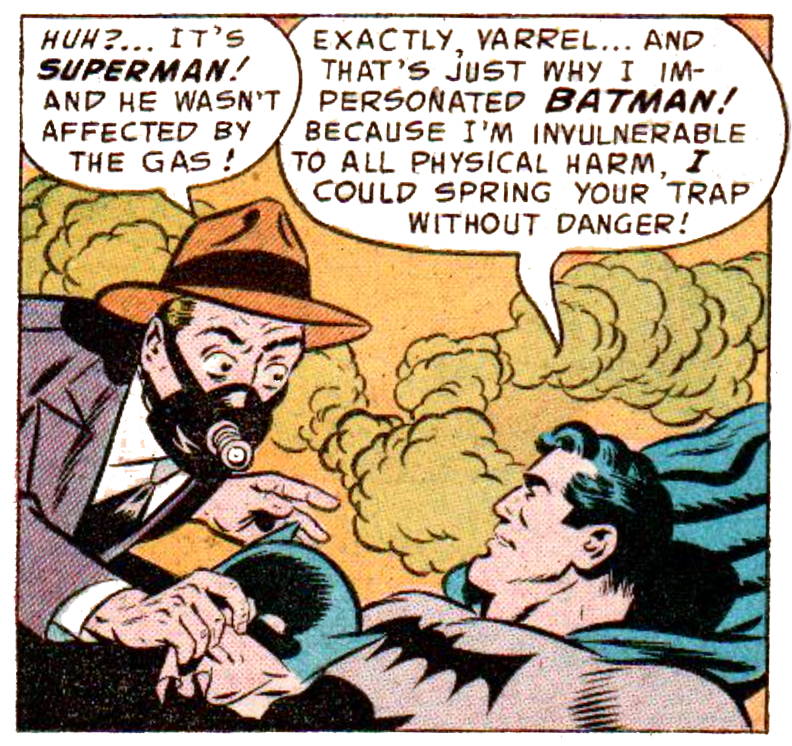
World’s Finest Comics #78 by Edmond Hamilton, Dick Sprang, & Stan Kaye (1955)
While Batman and Robin fight against the Varrel Mob (no connection to the Golden Age villain Jim Varrel) in Gotham, they spot a Bat-Signal in the night sky emanating from Metropolis. Superman summons Batman to his city via a long distance Bat-Signal of his own design. There, the Man of Steel explains that someone has been publicly exposing his secret ID as Clark Kent using blimps, graffiti, marquees, songs, and more. Batman puts the Varrel case on hold and starts investigating Superman’s case instead. At the opening of a new Aquarium designed by Superman, Bruce disguises himself as Clark to fool the public as usual. Eventually, Batman learns that someone has been filling in for him during his absence in Metropolis. What’s the deal? Superman had heard that the Varrel Mob was going to ice Batman, so he started exposing himself to lure Batman to the safety of Metropolis! Back in Gotham, Superman (dressed as Batman) takes down the Varrel Mob.
–REFERENCE: In Batman #93 Part 3 and World’s Finest Comics #107. Bruce and Dick meet and befriend Professor Carter Nichols who has developed a complicated “hypnosis method” that allows the subject to astral project an avatar of oneself into the past (or into the future). In other words, Nichols has invented a type of time-travel that works via a combination of his own unique metahuman ability with a high-tech device that emits an energy beam. (Note that I will sometimes use the term “metahuman” to mean “superhuman.” This word won’t be coined until the Modern Age, but in the future it will be DC’s primary descriptor for a super-powered individual.) Batman and Robin immediately go on several unspecified time traveling trips to test Nichols’ “hypnosis method” avatar time-machine, although we don’t know where Batman and Robin go for these tests. Furthermore, WFC #107 says that Batman and Robin go on “many” time-trips in their first three years, but in the Silver Age we only have four time-jaunts with Nichols in the first three years. Therefore, we have to simply imagine other time-trips listed below and sprinkled throughout years one through three. Of course, there may have been unspecified trips to the future in too, but for simplicity’s sake, I’m imagining only backward treks for these unspecified ones.
–Batman #93 Part 3[13]
When Bruce’s friend at the museum, Dr. Sayre, displays a cave painting that shows a Tyrannosaurus rex, the museum’s board of trustees threatens to fire him for creating a fake. Bruce and Dick travel back to the Stone Age (via the Carter Nichols method) to prove Dr. Sayre’s find is legit. In the Stone Age, Batman and Robin meet a caveman named Rog, humanity’s first ever masked superhero: Tiger Man. Batman introduces modern technology into Tiger Man’s repertoire and helps him defeat the evil Borr. In Borr’s cave lair, Batman is shocked to discover an intact T rex frozen in a glacier. When the glacier melts thanks to an accidental fire, the T rex comes back to life! However, due to its age and the drastic climate difference, the T rex dies right away. Back in 1967, the cave painting is reinterpreted thanks to the finding of an additional piece. Dr. Sayre is exonerated and credited with the find of the century.
–FLASHBACK: From Batman #304 Part 2. Batman gets grazed on the arm by two bullets. As Bruce, he goes to his old friend and regular physician Dr. Douglas Dundee, who patches him up with no questions asked. Dr. Dundee will patch-up Bruce from time-to-time with no questions asked, for the next five years.
–REFERENCE: In World’s Finest Comics #163 and Batman #94 Part 2 (where the giant penny is first shown). Batman deals with an escaped Joker and puts a stop to his “Bad Penny Crimes.” With Joker back behind bars, Batman collects a giant penny, which goes into the Batcave as a trophy.
–REFERENCE: In The Brave and The Bold #104. Batman takes on ambidextrous gun-toting gangster Waxey Doyle, who evades capture. Shortly thereafter, a brief gang war erupts in Gotham, during which Doyle goes missing and is regarded as is killed.
–REFERENCE: In Batman with Robin the Boy Wonder News Strip 5/31/1971 and DC Super-Stars #14 Part 2. Batman, along with GCPD Detective David Davis, busts gangster Sal Maroni (also spelled “Sal Morony” or “Sal Moroni”) after the latter kills rival Bookie Benson. Note that DC Super-Stars #14 Part 2 places this item as occurring “fifteen years” prior to its date of occurrence (fifteen years prior to 1979). However, that would put Two-Face’s debut prior to Batman’s debut. This is an error. Two-Face’s debut should be “twelve years” prior to DC Super-Stars #14 Part 2 instead of fifteen.
–REFERENCE: In The Brave and The Bold #69. Bruce reads about the death of famous scientist Dr. Elijah Carruthers, who had a reputation for being a mysterious and eccentric figure. Unknown to all, Carruthers has faked his death to live a secluded life in the countryside. We won’t see him again for a while.
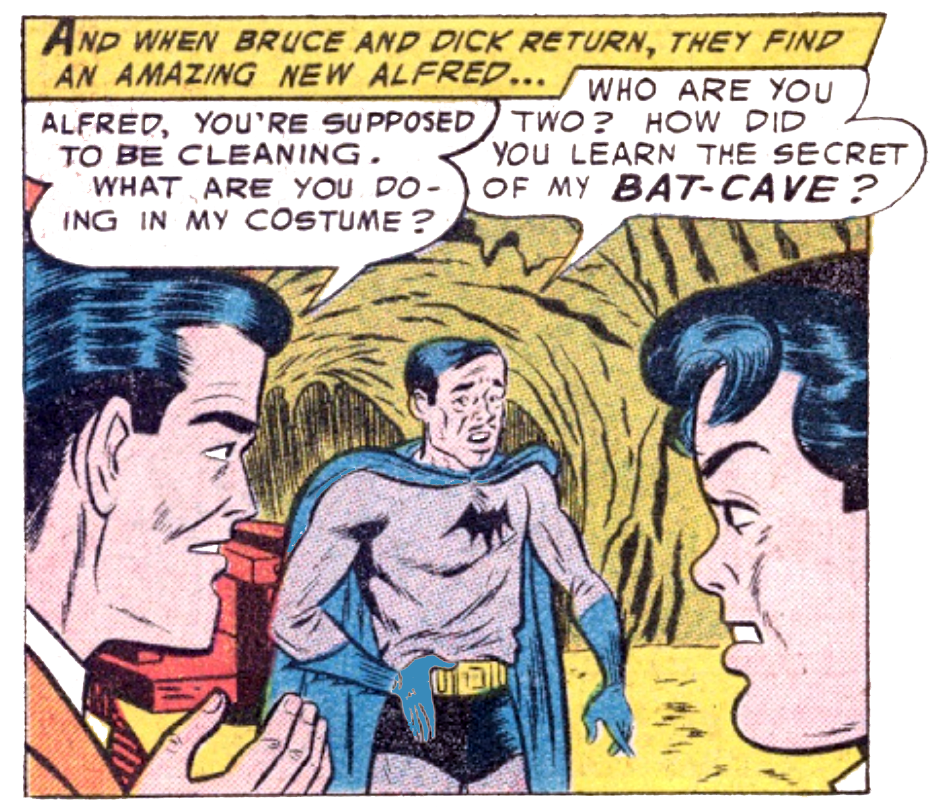
Batman #94 Part 2 by Edmond Hamilton, Sheldon Moldoff, & Stan Kaye (1955)
–Batman #94 Part 2[14]
Alfred wears the Batman costume just for kicks while he cleans the Batcave. While dusting, Catwoman’s catapult bonks him on the noggin and he goes out like a lamp. When he awakes, Alfred has temporary amnesia and thinks he is Batman! Bruce and Dick, worried that any sudden shock will do permanent damage, decided to play along. Bruce tells Alfred that he really is Batman and that he is the butler. A pathetic Alfred version of Batman accompanies Robin on a mission—Robin locks Alfred in a room, allowing the real deal to solve the case. The next day, a similar ruse is enacted so that Batman can successfully aid in escorting a test flight of a new jet. A day later, they do it again so that Batman can protect a jet-powered yacht. During the yacht gig, Alfred gets bonked on the dome once more, this time by would-be thieves, and regains his memory.
–REFERENCE: In World’s Finest Comics #175. Batman busts the fire-breathing arsonist super-villain known as The Flamethrower.
–REFERENCE: In World’s Finest Comics #81. Batman and Robin bust the Slaney Mob. Crime-lord Slaney goes to prison, but the rest of his gang walks for lack of evidence.
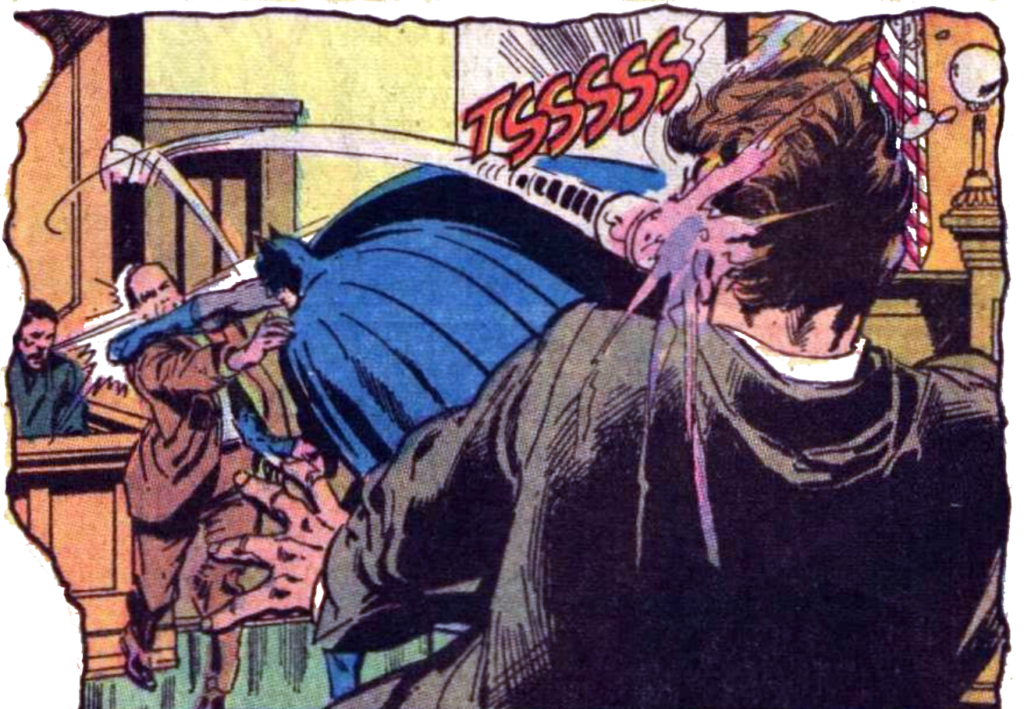
Batman #234 Part 1 by Denny O’Neil, Neal Adams, & Dick Giordano (1971)
–FLASHBACK: From Batman #234 Part 1, The Brave and The Bold #106, DC Super-Stars #14 Part 2, The Best of DC #14, Batman with Robin the Boy Wonder News Strip 5/31/1971 to 6/1/1971, and Detective Comics #563—and also referenced in Batman #329 Part 1, World’s Finest Comics #173, The Untold Legend of the Batman #1, and Detective Comics #563. Originally told in Detective Comics #66. Batman is in the courtroom when Gotham’s District Attorney, Harvey Dent, gets a vial of acid thrown in his face by gangster Sal Maroni. (Maroni actually wants to harm GCPD Detective David Davis, but he gets Dent by mistake.) Harvey goes into the hospital where he will remain for the next month. (Note that some flashbacks show Batman wearing his yellow oval costume in the courtroom while others show him wearing his black insignia costume. Technically, he could be wearing either one, but it’s likely he was wearing the latter.)
–REFERENCE: In Batman #152 Part 3. Batman and Robin meet and befriend elderly mineralogist Luke Haley and US Army medic Dr. Robbins.
–REFERENCE: In World’s Finest Comics #150. Batman studies genius mathematician Von Sedlitz’s Theory of Games.
–REFERENCE: In The Brave and The Bold #71. Batman befriends wealthy Native American business tycoon John Whitebird. Batman and Whitebird will hang out from time-to-time, albeit invisibly, moving forward on our chronology.
–REFERENCE: In Batman #192 Part 1. In Batman #192 Part 1, editorial narration says that on “occasions when he is called upon to mend broken hearts, the Caped Crusader is most sympathetic.” This means that Batman now gets involved in the romantic struggles of some troubled couple, helping them. Bet you didn’t know Batman was a love guru too! The implication is that Batman will help other couples along the way, moving forward, although we (sadly) won’t see this physically appearing on our timeline.
–REFERENCE: In Batman #196 Part 1. Batman busts crooks Joey Tolliver, Hank, and Kenny.
–REFERENCE: In Batman #199 Part 1 and Detective Comics #485. Batman and Robin familiarize themselves with the specs of all manner of personal and commercial vehicles in Gotham, also familiarizing themselves with license plates and license plate letter coding. Batman, with his eidetic memory, will begin the practice of memorizing nearly every suspicious license plate he sees.
–REFERENCE: In The Untold Legend of the Batman #1 and Batman with The Boy Wonder News Strip 12/3/1971. Batman busts an unnamed crook, who will later become one of Joe Chill’s henchmen.
–REFERENCE: In Action Comics #366. Superman, as a gift, gives Batman an anti-gravity belt that allows its user to fly.
–REFERENCE: In Detective Comics #364. Bruce befriends multimillionaire Kevin Jackson and his wife Mrs. Jackson and hangs out with them at their mansion on Millionaire’s Row, a wealthy suburb of Gotham. Bruce will hang out with the Jacksons from time to time, although we won’t see these hangouts on our timeline.
–REFERENCE: In Detective Comics #385. Batman busts some unnamed random criminals, who will eventually meet up and form a conspiracy to get murderous revenge, years later. In ‘tec #385, which occurs in Year 8, there are seven bad guys involved in the conspiracy. It is unknown if Batman busts all seven of these guys now or if they are not-originally-connected and busted sporadically throughout the next couple years. Thus, we can imagine either some of them being busted now or some busted now with the rest busted later. We can even imagine that these unnamed dudes are other unnamed baddies—random crooks or henchmen—shown in other upcoming comics, but there’s no way of confirming this.
–REFERENCE: In Detective Comics #391, Batman #225 Part 1, and Batman #255. Bruce becomes a member of and begins visiting a high-end spa/training gym called The Gotham Health Club (aka The Gotham Athletic Club aka The Gotham Men’s Athletic Club). Bruce begins getting regular massages from a physical therapists Tim Clark and Ernst. He also quickly befriends the Club’s security guard Andy Forsythe.
–REFERENCE: In Detective Comics #449. Bruce meets multimillionaire trucking tycoon Zachary Wolfe, befriending him in the social scene. Bruce will hangout with Wolfe from time-to-time, moving forward, but it’ll be mostly for keeping up playboy appearances.
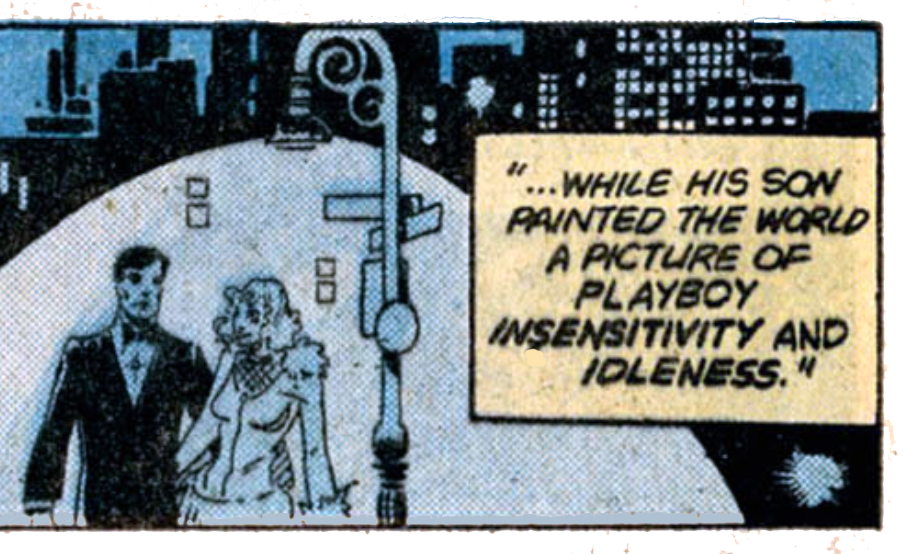
Detective Comics #481 Part 5 by Jim Starlin, P Craig Russell, & Tatjana Wood (1979)
–FLASHBACK: From Detective Comics #481 Part 5. Thomas Wayne’s wartime associate Xavier Simon, who vowed to get revenge against Thomas for testifying against him during WWI, refocuses his revenge plot against Bruce. Simon, now with paraplegia, sends private detectives to spy on Bruce. One these private eyes watches as Bruce goes on a random date with a pretty gal. Unknown to Bruce, Simon’s men will watch him for over a decade-plus, eventually discovering that he is Batman!
–REFERENCE: In Detective Comics #386. Bruce exposes fraudulent business practices of a partner, aircraft manufacturing tycoon Carlyle Crane, whose company has been using cheaper faulty equipment when building US military-contracted planes. Crane’s business empire is ruined and he swears bloody vengeance upon Bruce. Crane will spend five years in prison and then nearly two years plotting revenge before we see him again.
–REFERENCE: In Batman and The Outsiders #3. Batman comes up with a special “channel seven” code for Alfred, which lets him know to prepare for unexpected visitors being brought to the Batcave.
–REFERENCE: In Batman #189 and Batman #200—originally told in World’s Finest Comics #3. Scarecrow (Dr. Jonathan Crane) debuts, using what will become his signature fear-based crime tactics to plague Gotham. Batman and Robin fight Scarecrow, who pulls of a series of heists, leaving straw at each crime scene as a calling card. Scarecrow is eventually defeated, but he is able to hide his stolen loot away before going behind bars to serve a long sentence. Notably, it makes sense to mirror the Golden Age by having Scarecrow debut before Two-Face. (This is reflected in our timeline here.) However, since there’s technically nothing in Batman #189 or Batman #200 that tells us exactly when Scarecrow debuts in the Silver Age, his debut could easily go anywhere within the first six years of Batman’s career. It’s entirely up to you.
–REFERENCE: In Batman #309. December 24. Batman gives Commissioner Gordon pipe tobacco for an Xmas present. Gordon asks what Batman wants in return, so he gives him a list of charities to which he’d like to give donations. Gordon will donate to these charities in Batman’s name every Xmas in the future.
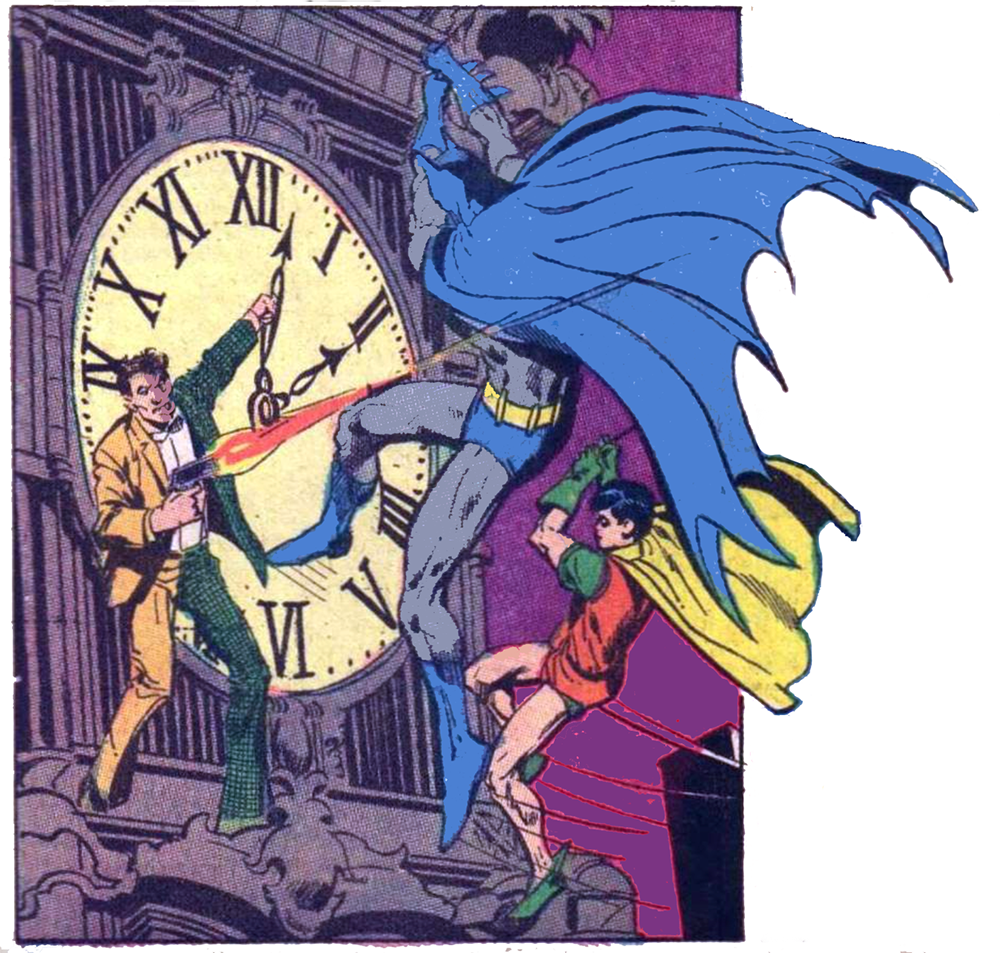
Batman #234 Part 1 by Denny O’Neil, Neal Adams, & Dick Giordano (1971)
–FLASHBACK: From Batman #234 Part 1 and DC Super-Stars #14 Part 2—and also referenced in Batman #329 Part 1, World’s Finest Comics #173, The Untold Legend of the Batman #1, and Detective Comics #563. Originally told in Detective Comics #66. Harvey Dent has been in the hospital for a month. Batman and Harvey’s girlfriend Gilda Gold are now on hand when the bandages come off. Scarred both physically and emotionally, Dent freaks out and becomes the super-villain Two-Face. He challenges Batman and Robin, who bring him to justice. Batman befriends poor Gilda, helping her through this terrible time. Batman will remain close friends with Gilda for decades to come, so, while we won’t see their interactions on our timeline, we must imagine them occurring every now and again. Note that DC Super-Stars #14 Part 2 incorrectly places this item as occurring “fifteen years” prior to its date of occurrence (fifteen years prior to 1979). Two-Face’s debut should be “twelve years” prior to DC Super-Stars #14 Part 2. Also note that the 6/1/1971 News Strip flashback ignores Davis’s part in the story because it was written long before the Davis retcon addition. And also note that the flashback from Batman #329 Part 1 shows Batman wearing the wrong costume. And last but not least, the ever-unreliable 1976 Super DC Calendar says incorrectly that Dent is scarred by acid in May and becomes Two-Face in June. (They get the month gap right, but the months themselves are incorrect.)
_______________________________
_______________________________________________________________________________________
_______________________________
<<< Early Years <<< | >>> Year Two >>>
- [1]COLLIN COLSHER: Some reputable timelines, including the 5 Earths Project, place Batman’s Earth-1 debut in 1970. Others place it in 1969. I, however, have given some extra breathing room (two or three years, depending on which other timeline you are comparing mine to) in order to fit-in various canonical stories, Golden Age references, and retcon details that I feel are essential to the chronology. While technically plausible that there could be even more breathing room here, pushing Batman’s debut earlier than 1967 would likely give us problematic character ages that wouldn’t jibe with later stories.↩
- [2]COLLIN COLSHER: The Silver Age/Earth-1 Batman chronology operates like a calendar, running from January to December each year.↩
- [3]COLLIN COLSHER: Rationale for Bruce’s age: The Untold Legend of Batman #1 tells us that Bruce starts college at age 18. The 1976 Super DC Calendar and Batman Family #11 tell us Bruce’s birthday is in February. This means the earliest Bruce can start school realistically is in a June-beginning summer trimester. Assuming genius Bruce goes full-time summer, fall, and spring sessions, he could graduate after completing eight trimesters, which would make him twenty-years-old when he graduates in December 1966. Therefore, he will be twenty-years-old when he becomes Batman, but turn twenty-one in two months’ time (in February). Denny O’Neil also once famously said that Earth-1 Bruce Wayne became Batman before he turned 21. True! (Note that Batman with Robin the Boy Wonder News Strip 2/28/1969 gives birthdates for Batman, Robin, Aunt Harriet, and Alfred, but they are either incorrect or were later retconned by the 1976 Super DC Calendar).↩
- [4]COLLIN COLSHER: Wayne Enterprises is a corporation (Inc) that is the parent conglomerate of various other corporations and LLCs. It is publicly traded on the stock market, meaning that it has shareholders and a board of directors. However, a single CEO is in direct charge of all business affairs. Bob Haney, in World’s Finest Comics #249, mistakenly refers to Wayne Enterprises as a hybrid unlimited (ULL) company. This is wrong. ULLs or ULCs really only exist in the UK and Canada, so it’s weird that Haney even went there. But, then again, Haney is a pretty weird dude.↩
- [5]COLLIN COLSHER: Despite vowing never to use lethal force, Batman will make exceptions to this rule. The first exception to the rule will be in regard to immortals (specifically, those who have extended their lifespan via unnatural means)—as we will see with the Muertos in Detective Comics #395, with Ubu in Detective Comics #438, with Catman in Detective Comics #509, and multiple times with Ra’s al Ghul in various issues. I guess Batman feels that, since immortals will always come back, it’s okay to use deadlier force against them. The second exception to the rule will be in regard to vampires/the undead (as we will see in Batman #235, Detective Comics #455, and The Brave and The Bold #195). Here’s the big question, though. When does Batman kill in self-defense in the Silver/Bronze Age? ComicTropes has an excellent video about this very topic, but I’ll break it down for you with an easy to digest list below. These are all the possible (some are debatable) Earth-1 Bat-killings via self-defense. Spoilers ahead!
–“The Case of the Chemical Syndicate” – Batman punches a crook into vat of chemicals.
–Batman #1 – Batman guns down a couple of Hugo Strange’s Monster Men, hangs a Monster Man, and knocks a Monster Man off a building.
–Batman #221 – Batman judo tosses a henchman to his death.
–The Brave and The Bold #90 – Batman tosses a villain into the ocean, killing him.
–Batman #235 – Batman knocks a League of Assassins scientist into deadly chemicals.
–Batman #270 – Batman punches a crook into a statue, which crushes him to death.
–Batman #271 – Batman blows up about fifteen cultists.
–Batman #288 – Batman uses a henchman as a human shield as Penguin shoots at him.
–Batman #290 – Batman judo tosses Skull Duggar into an electrified power box.
–The Brave and The Bold #157 – Batman causes a kidnapper to crash his helicopter.
–The Brave and The Bold #159 – Batman tosses a League of Assassins henchman into Ra’s al Ghul’s crystal death wall.
–Batman #340 – Batman kills The Mole, although we never actually see a body.
–The Brave and The Bold #193 – Batman judo tosses Bloodclaw of the PLA off of a bridge.
In total, we have somewhere around thirty Bat-killings in self-defense. Although, some instances are vague and open to interpretation. Thus, this list merely comprises possible killings. While not included above, The Brave and The Bold #127 is notable because it shows Batman ignore a distress call, which leads to a fatal helicopter crash. Many online sources regard this as a kill, but I lean the other way on this one. Also not included above, Detective Comics #517 is notable because it shows Batman himself turn into vampire and bite someone, but it’s unclear whether or not the victim dies (or whether this even would be considered a self-defense scenario in the first place). Likewise, Batman Annual #9 Part 2 appears to contain a straight-up violation of Batman’s no killing code, showing the Dark Knight directly incite gang bloodshed. The latter is written by Mike W Barr, who—along with David Vern Reed, Bob Haney, and Denny O’Neil—arguably penned the most extremely violent Batman comics once the Bronze Age started. Stories by Barr, Reed, Haney, and O’Neil in the 1970s and early 1980s certainly seem to depict Batman sometimes dishing out a level of viciousness that could potentially be fatal, but we have to assume Batman knows exactly what he’s doing, keeping folks maimed but alive. Again, Batman has a legitimate no killing code, so we (the readers) have to suspend our disbelief a bit to ensure he keeps it! For more details about Batman killing people, check out my informative article aptly titled, “The Complicated History of Batman Killing People.”↩ - [6]COLLIN COLSHER: The Best of DC #14 shows Catwoman’s origin story and reveals that Selina Kyle does indeed get serious amnesia after surviving a plane crash, a terrible event that occurs shortly before she starts her criminal career. While the accident and resultant amnesia are factual, we have no way of knowing whether or not her split-personality story is bullshit or not. Odds are, however, that it’s totally made-up. Furthermore, Batman #208 seems to lean toward the idea that it’s made-up.↩
- [7]COLLIN COLSHER / AARON SEVERSON: Superman #76 is a Golden Age tale (published May 1952) that features the first ever published instance of Batman and Superman learning each other’s secret identities. However, thanks to numerous retcons, Superman #76 is non-canon in the Golden Age and canon only in the Silver Age. As established in World’s Finest Comics #271, published in 1981, the Adventures of Superman radio serial was part of Earth-2 continuity. In the radio series, Batman and Superman first join forces and learn each other’s true identities in March 1945. World’s Finest #271 establishes that the radio serial adventure details Batman and Superman’s first case together on Earth-2, while the events of Superman #76 take place only on Earth-1. So, to reiterate: Superman #76 is non-canon on Earth-2 but canon on Earth-1, hence its inclusion here! It’s also worth noting that the highly-dubious 1976 Super DC Calendar places this first meeting between Clark and Bruce specifically on March 10, but this is plain wrong.↩
- [8]COLLIN COLSHER / AARON SEVERSON: World’s Finest Comics #71 is a Golden Age story (published July 1954). However, this issue is only canon on the Silver Age timeline for several reasons: one, because it directly references and acts as a direct follow-up to the Earth-1 canonical Superman #76 (even showing a flashback to Superman #76); two, because because it violates the Golden Age retcon that Clark and Lois were married on Earth-2; and three, because it is directly referenced in the Silver Age’s WFC #264.↩
- [9]COLLIN COLSHER: In Year 16 of the Golden Age timeline, a mayoral election is being held (as originally referenced in Batman #85 Part 1). We don’t learn anything about who is running, nor do we see any of the candidates. We only see a banner that says “Vote for Alan Dent.” Subsequently, in Batman #87, and Batman #91 Part 2, we were introduced to a new unnamed mayor. I took the liberty of applying the Alan Dent name to him. I see no reason to alter that for the Silver Age.↩
- [10]COLLIN COLSHER: World’s Finest Comics #72 is a Golden Age issue (published September 1954). However, 1981 retcons dictate that Lois and Clark are married on Earth-2. Since they are not married in WFC #72, this tale gets moved from the Earth-2 timeline to the Earth-1 timeline, hence its placement here.↩
- [11]COLLIN COLSHER: World’s Finest Comics #76 is a Golden Age issue (published May 1955). However, since 1981 retcons dictate that Lois and Clark are married on the Earth-2 timeline and they are shown not to be in WFC #76, this story occurs on Earth-1, hence placement here.↩
- [12]COLLIN COLSHER: WFC #77-78 is a Golden Age run (published July 1955 through September 1955). However, these two issues have been retconned to the Silver Age timeline because, in them, Lois and Clark are not married, which violates Earth-2 retcons from 1981.↩
- [13]COLLIN COLSHER: Batman #93 Part 3 is a Golden Age story (published August 1955). However, it is non-canon on Earth-2 (and only canon on Earth-1) because Bruce is referred to as a “playboy” in it. This reference doesn’t jibe with the Earth-2 timeline because Bruce is engaged to be married on that timeline. Hence, Batman #93 Part 3 has retcon-migrated here.↩
- [14]COLLIN COLSHER: Batman #94 Part 2 is a Golden Age story (published September 1955). However, it is non-canon on Earth-2 (and only canon on Earth-1) because Bruce is referred to as a “playboy” in it. This reference doesn’t jibe with the Earth-2 timeline because Bruce is married on that timeline. Hence, Batman #94 Part 2 has retcon-migrated here.↩

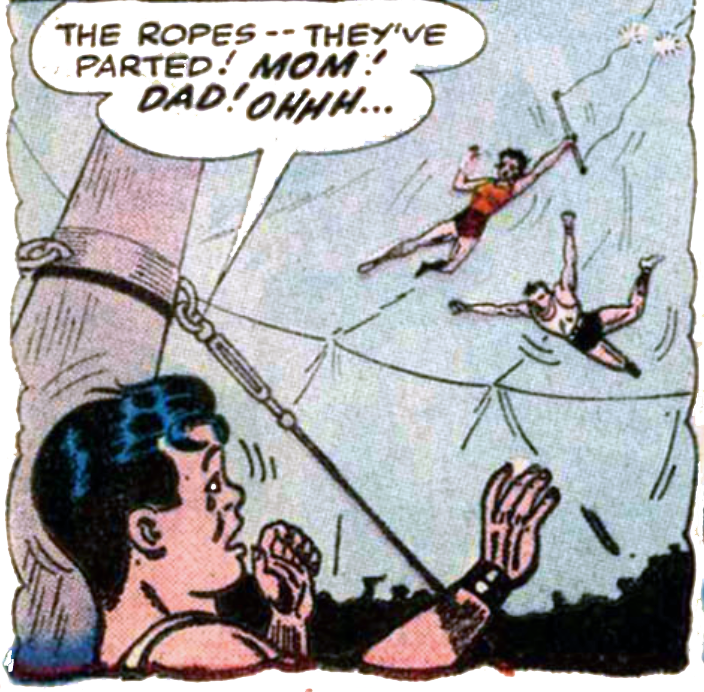

Quick question: While four out of the five stories in Batman #213 are reprints, the first one is a new retelling of the origin of Robin, which I feel cleverly combines a lot of facts from various tellings. Would it also not be a good point of reference along with the other ones you have listed for Robin’s origin?
First of all, great project, I love it!
I’ve noticed a small typo on this page — “Batman #471-472” should be “Detective Comics #471-472”, those are 3 mentions of Hugo Strange.
Oh yes, of course. Thanks Andrew!